Project and Programme Management: Cross Rail
VerifiedAdded on 2023/06/06
|22
|5978
|225
AI Summary
This report covers the life cycle of Cross Rail project and innovative approaches in project management. It evaluates the relationship between effective techniques of project management, leadership, implementing project and project planning. It also covers the evaluation of contemporary project management practices and leadership styles in an organisation.
Contribute Materials
Your contribution can guide someone’s learning journey. Share your
documents today.
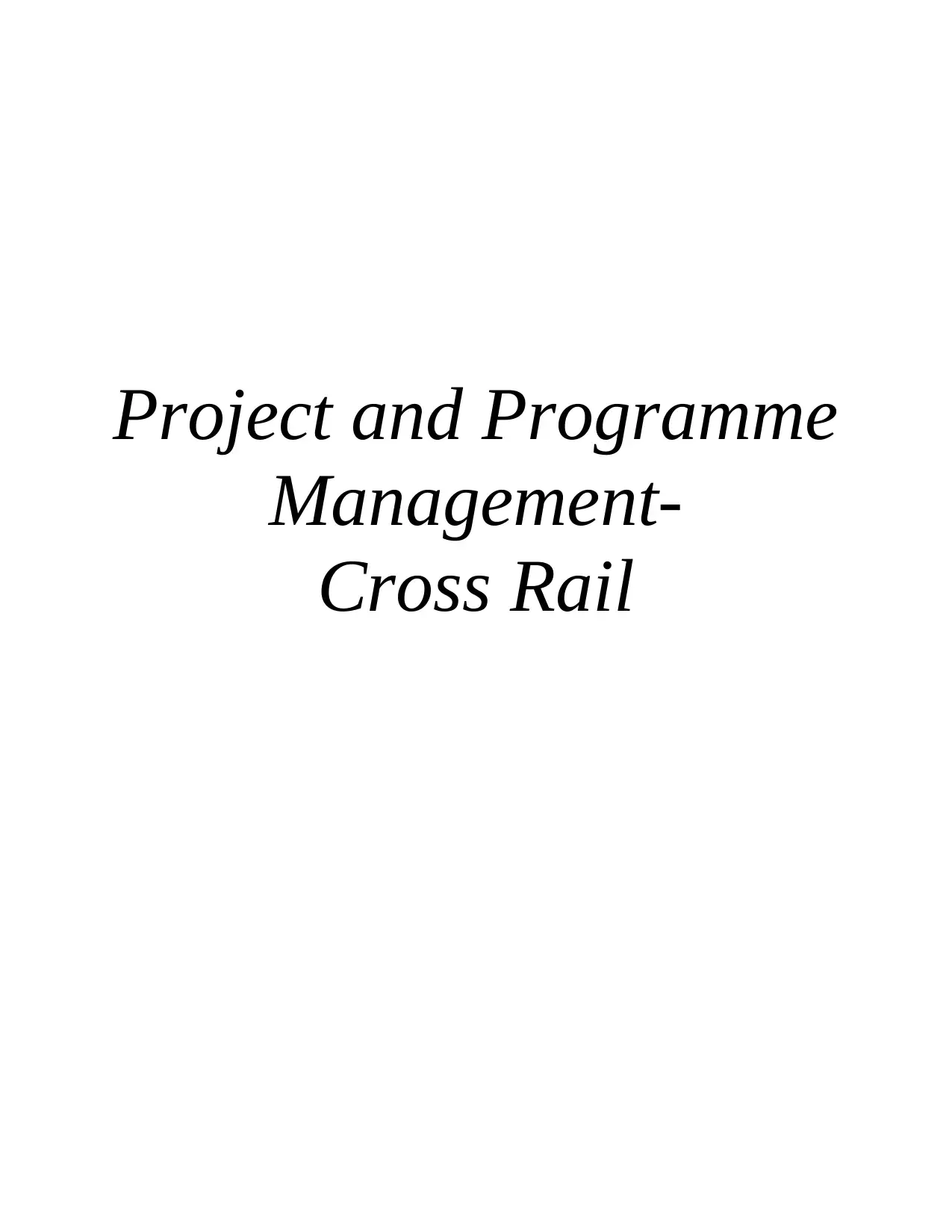
Project and Programme
Management-
Cross Rail
Management-
Cross Rail
Secure Best Marks with AI Grader
Need help grading? Try our AI Grader for instant feedback on your assignments.
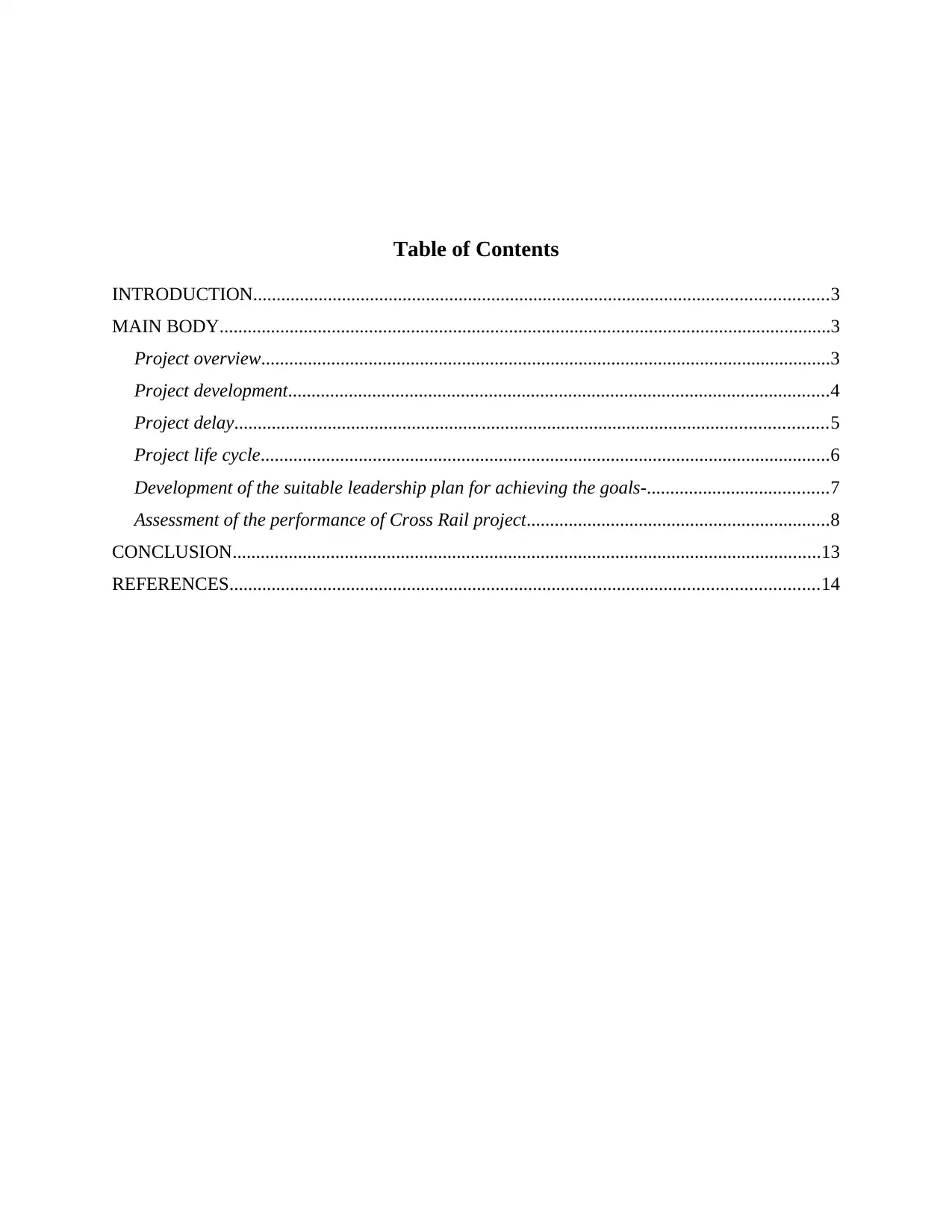
Table of Contents
INTRODUCTION...........................................................................................................................3
MAIN BODY...................................................................................................................................3
Project overview..........................................................................................................................3
Project development....................................................................................................................4
Project delay...............................................................................................................................5
Project life cycle..........................................................................................................................6
Development of the suitable leadership plan for achieving the goals-.......................................7
Assessment of the performance of Cross Rail project.................................................................8
CONCLUSION..............................................................................................................................13
REFERENCES..............................................................................................................................14
INTRODUCTION...........................................................................................................................3
MAIN BODY...................................................................................................................................3
Project overview..........................................................................................................................3
Project development....................................................................................................................4
Project delay...............................................................................................................................5
Project life cycle..........................................................................................................................6
Development of the suitable leadership plan for achieving the goals-.......................................7
Assessment of the performance of Cross Rail project.................................................................8
CONCLUSION..............................................................................................................................13
REFERENCES..............................................................................................................................14
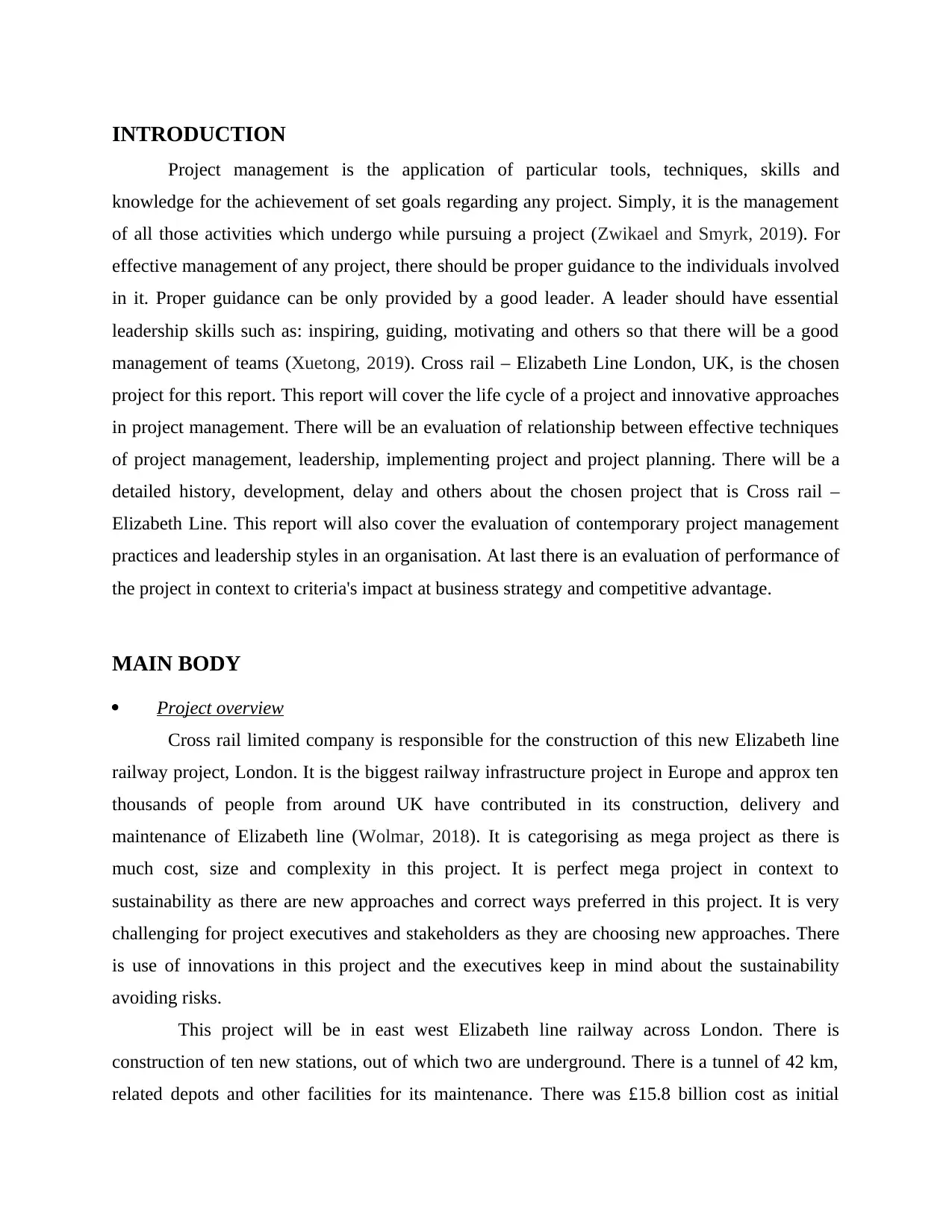
INTRODUCTION
Project management is the application of particular tools, techniques, skills and
knowledge for the achievement of set goals regarding any project. Simply, it is the management
of all those activities which undergo while pursuing a project (Zwikael and Smyrk, 2019). For
effective management of any project, there should be proper guidance to the individuals involved
in it. Proper guidance can be only provided by a good leader. A leader should have essential
leadership skills such as: inspiring, guiding, motivating and others so that there will be a good
management of teams (Xuetong, 2019). Cross rail – Elizabeth Line London, UK, is the chosen
project for this report. This report will cover the life cycle of a project and innovative approaches
in project management. There will be an evaluation of relationship between effective techniques
of project management, leadership, implementing project and project planning. There will be a
detailed history, development, delay and others about the chosen project that is Cross rail –
Elizabeth Line. This report will also cover the evaluation of contemporary project management
practices and leadership styles in an organisation. At last there is an evaluation of performance of
the project in context to criteria's impact at business strategy and competitive advantage.
MAIN BODY
Project overview
Cross rail limited company is responsible for the construction of this new Elizabeth line
railway project, London. It is the biggest railway infrastructure project in Europe and approx ten
thousands of people from around UK have contributed in its construction, delivery and
maintenance of Elizabeth line (Wolmar, 2018). It is categorising as mega project as there is
much cost, size and complexity in this project. It is perfect mega project in context to
sustainability as there are new approaches and correct ways preferred in this project. It is very
challenging for project executives and stakeholders as they are choosing new approaches. There
is use of innovations in this project and the executives keep in mind about the sustainability
avoiding risks.
This project will be in east west Elizabeth line railway across London. There is
construction of ten new stations, out of which two are underground. There is a tunnel of 42 km,
related depots and other facilities for its maintenance. There was £15.8 billion cost as initial
Project management is the application of particular tools, techniques, skills and
knowledge for the achievement of set goals regarding any project. Simply, it is the management
of all those activities which undergo while pursuing a project (Zwikael and Smyrk, 2019). For
effective management of any project, there should be proper guidance to the individuals involved
in it. Proper guidance can be only provided by a good leader. A leader should have essential
leadership skills such as: inspiring, guiding, motivating and others so that there will be a good
management of teams (Xuetong, 2019). Cross rail – Elizabeth Line London, UK, is the chosen
project for this report. This report will cover the life cycle of a project and innovative approaches
in project management. There will be an evaluation of relationship between effective techniques
of project management, leadership, implementing project and project planning. There will be a
detailed history, development, delay and others about the chosen project that is Cross rail –
Elizabeth Line. This report will also cover the evaluation of contemporary project management
practices and leadership styles in an organisation. At last there is an evaluation of performance of
the project in context to criteria's impact at business strategy and competitive advantage.
MAIN BODY
Project overview
Cross rail limited company is responsible for the construction of this new Elizabeth line
railway project, London. It is the biggest railway infrastructure project in Europe and approx ten
thousands of people from around UK have contributed in its construction, delivery and
maintenance of Elizabeth line (Wolmar, 2018). It is categorising as mega project as there is
much cost, size and complexity in this project. It is perfect mega project in context to
sustainability as there are new approaches and correct ways preferred in this project. It is very
challenging for project executives and stakeholders as they are choosing new approaches. There
is use of innovations in this project and the executives keep in mind about the sustainability
avoiding risks.
This project will be in east west Elizabeth line railway across London. There is
construction of ten new stations, out of which two are underground. There is a tunnel of 42 km,
related depots and other facilities for its maintenance. There was £15.8 billion cost as initial
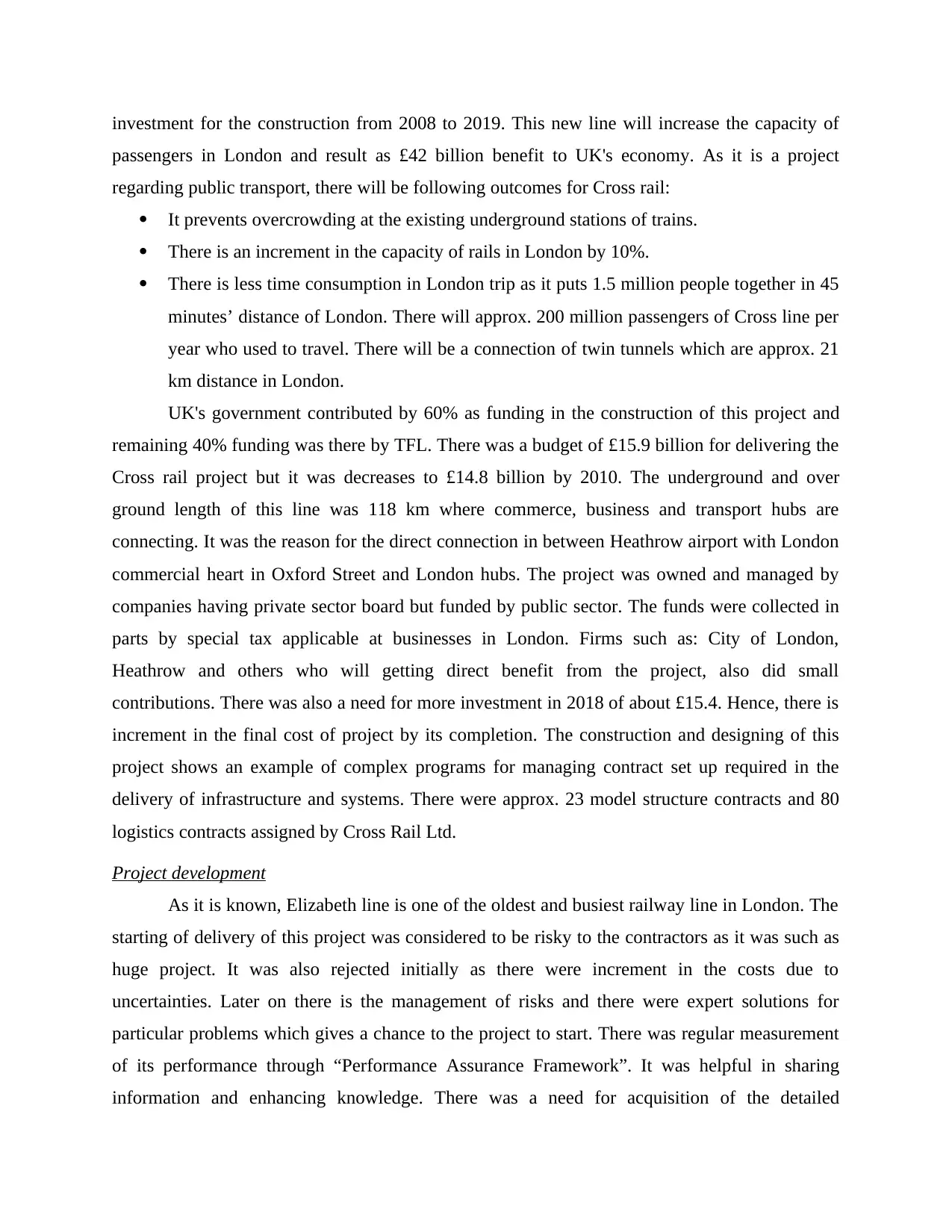
investment for the construction from 2008 to 2019. This new line will increase the capacity of
passengers in London and result as £42 billion benefit to UK's economy. As it is a project
regarding public transport, there will be following outcomes for Cross rail:
It prevents overcrowding at the existing underground stations of trains.
There is an increment in the capacity of rails in London by 10%.
There is less time consumption in London trip as it puts 1.5 million people together in 45
minutes’ distance of London. There will approx. 200 million passengers of Cross line per
year who used to travel. There will be a connection of twin tunnels which are approx. 21
km distance in London.
UK's government contributed by 60% as funding in the construction of this project and
remaining 40% funding was there by TFL. There was a budget of £15.9 billion for delivering the
Cross rail project but it was decreases to £14.8 billion by 2010. The underground and over
ground length of this line was 118 km where commerce, business and transport hubs are
connecting. It was the reason for the direct connection in between Heathrow airport with London
commercial heart in Oxford Street and London hubs. The project was owned and managed by
companies having private sector board but funded by public sector. The funds were collected in
parts by special tax applicable at businesses in London. Firms such as: City of London,
Heathrow and others who will getting direct benefit from the project, also did small
contributions. There was also a need for more investment in 2018 of about £15.4. Hence, there is
increment in the final cost of project by its completion. The construction and designing of this
project shows an example of complex programs for managing contract set up required in the
delivery of infrastructure and systems. There were approx. 23 model structure contracts and 80
logistics contracts assigned by Cross Rail Ltd.
Project development
As it is known, Elizabeth line is one of the oldest and busiest railway line in London. The
starting of delivery of this project was considered to be risky to the contractors as it was such as
huge project. It was also rejected initially as there were increment in the costs due to
uncertainties. Later on there is the management of risks and there were expert solutions for
particular problems which gives a chance to the project to start. There was regular measurement
of its performance through “Performance Assurance Framework”. It was helpful in sharing
information and enhancing knowledge. There was a need for acquisition of the detailed
passengers in London and result as £42 billion benefit to UK's economy. As it is a project
regarding public transport, there will be following outcomes for Cross rail:
It prevents overcrowding at the existing underground stations of trains.
There is an increment in the capacity of rails in London by 10%.
There is less time consumption in London trip as it puts 1.5 million people together in 45
minutes’ distance of London. There will approx. 200 million passengers of Cross line per
year who used to travel. There will be a connection of twin tunnels which are approx. 21
km distance in London.
UK's government contributed by 60% as funding in the construction of this project and
remaining 40% funding was there by TFL. There was a budget of £15.9 billion for delivering the
Cross rail project but it was decreases to £14.8 billion by 2010. The underground and over
ground length of this line was 118 km where commerce, business and transport hubs are
connecting. It was the reason for the direct connection in between Heathrow airport with London
commercial heart in Oxford Street and London hubs. The project was owned and managed by
companies having private sector board but funded by public sector. The funds were collected in
parts by special tax applicable at businesses in London. Firms such as: City of London,
Heathrow and others who will getting direct benefit from the project, also did small
contributions. There was also a need for more investment in 2018 of about £15.4. Hence, there is
increment in the final cost of project by its completion. The construction and designing of this
project shows an example of complex programs for managing contract set up required in the
delivery of infrastructure and systems. There were approx. 23 model structure contracts and 80
logistics contracts assigned by Cross Rail Ltd.
Project development
As it is known, Elizabeth line is one of the oldest and busiest railway line in London. The
starting of delivery of this project was considered to be risky to the contractors as it was such as
huge project. It was also rejected initially as there were increment in the costs due to
uncertainties. Later on there is the management of risks and there were expert solutions for
particular problems which gives a chance to the project to start. There was regular measurement
of its performance through “Performance Assurance Framework”. It was helpful in sharing
information and enhancing knowledge. There was a need for acquisition of the detailed
Secure Best Marks with AI Grader
Need help grading? Try our AI Grader for instant feedback on your assignments.
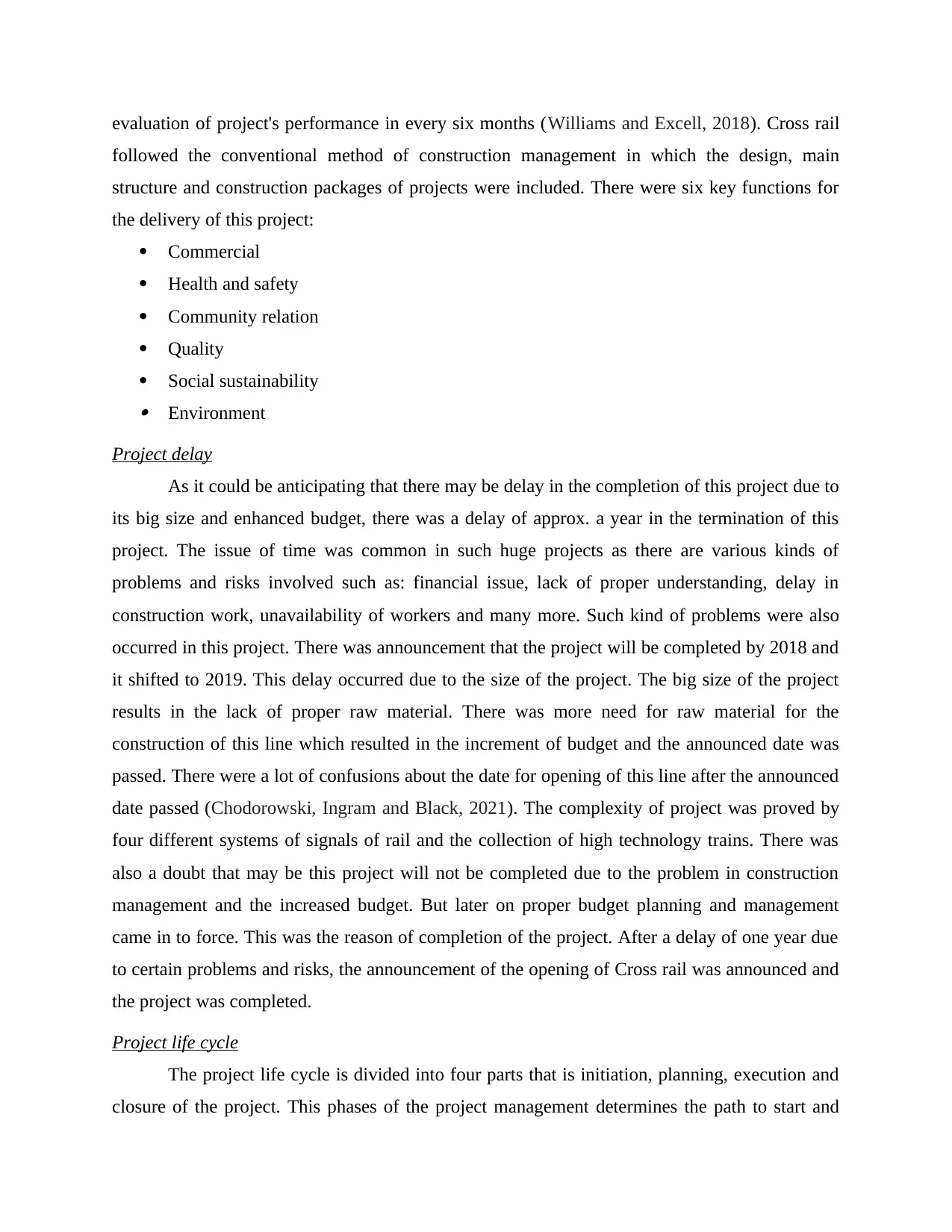
evaluation of project's performance in every six months (Williams and Excell, 2018). Cross rail
followed the conventional method of construction management in which the design, main
structure and construction packages of projects were included. There were six key functions for
the delivery of this project:
Commercial
Health and safety
Community relation
Quality
Social sustainability Environment
Project delay
As it could be anticipating that there may be delay in the completion of this project due to
its big size and enhanced budget, there was a delay of approx. a year in the termination of this
project. The issue of time was common in such huge projects as there are various kinds of
problems and risks involved such as: financial issue, lack of proper understanding, delay in
construction work, unavailability of workers and many more. Such kind of problems were also
occurred in this project. There was announcement that the project will be completed by 2018 and
it shifted to 2019. This delay occurred due to the size of the project. The big size of the project
results in the lack of proper raw material. There was more need for raw material for the
construction of this line which resulted in the increment of budget and the announced date was
passed. There were a lot of confusions about the date for opening of this line after the announced
date passed (Chodorowski, Ingram and Black, 2021). The complexity of project was proved by
four different systems of signals of rail and the collection of high technology trains. There was
also a doubt that may be this project will not be completed due to the problem in construction
management and the increased budget. But later on proper budget planning and management
came in to force. This was the reason of completion of the project. After a delay of one year due
to certain problems and risks, the announcement of the opening of Cross rail was announced and
the project was completed.
Project life cycle
The project life cycle is divided into four parts that is initiation, planning, execution and
closure of the project. This phases of the project management determines the path to start and
followed the conventional method of construction management in which the design, main
structure and construction packages of projects were included. There were six key functions for
the delivery of this project:
Commercial
Health and safety
Community relation
Quality
Social sustainability Environment
Project delay
As it could be anticipating that there may be delay in the completion of this project due to
its big size and enhanced budget, there was a delay of approx. a year in the termination of this
project. The issue of time was common in such huge projects as there are various kinds of
problems and risks involved such as: financial issue, lack of proper understanding, delay in
construction work, unavailability of workers and many more. Such kind of problems were also
occurred in this project. There was announcement that the project will be completed by 2018 and
it shifted to 2019. This delay occurred due to the size of the project. The big size of the project
results in the lack of proper raw material. There was more need for raw material for the
construction of this line which resulted in the increment of budget and the announced date was
passed. There were a lot of confusions about the date for opening of this line after the announced
date passed (Chodorowski, Ingram and Black, 2021). The complexity of project was proved by
four different systems of signals of rail and the collection of high technology trains. There was
also a doubt that may be this project will not be completed due to the problem in construction
management and the increased budget. But later on proper budget planning and management
came in to force. This was the reason of completion of the project. After a delay of one year due
to certain problems and risks, the announcement of the opening of Cross rail was announced and
the project was completed.
Project life cycle
The project life cycle is divided into four parts that is initiation, planning, execution and
closure of the project. This phases of the project management determines the path to start and
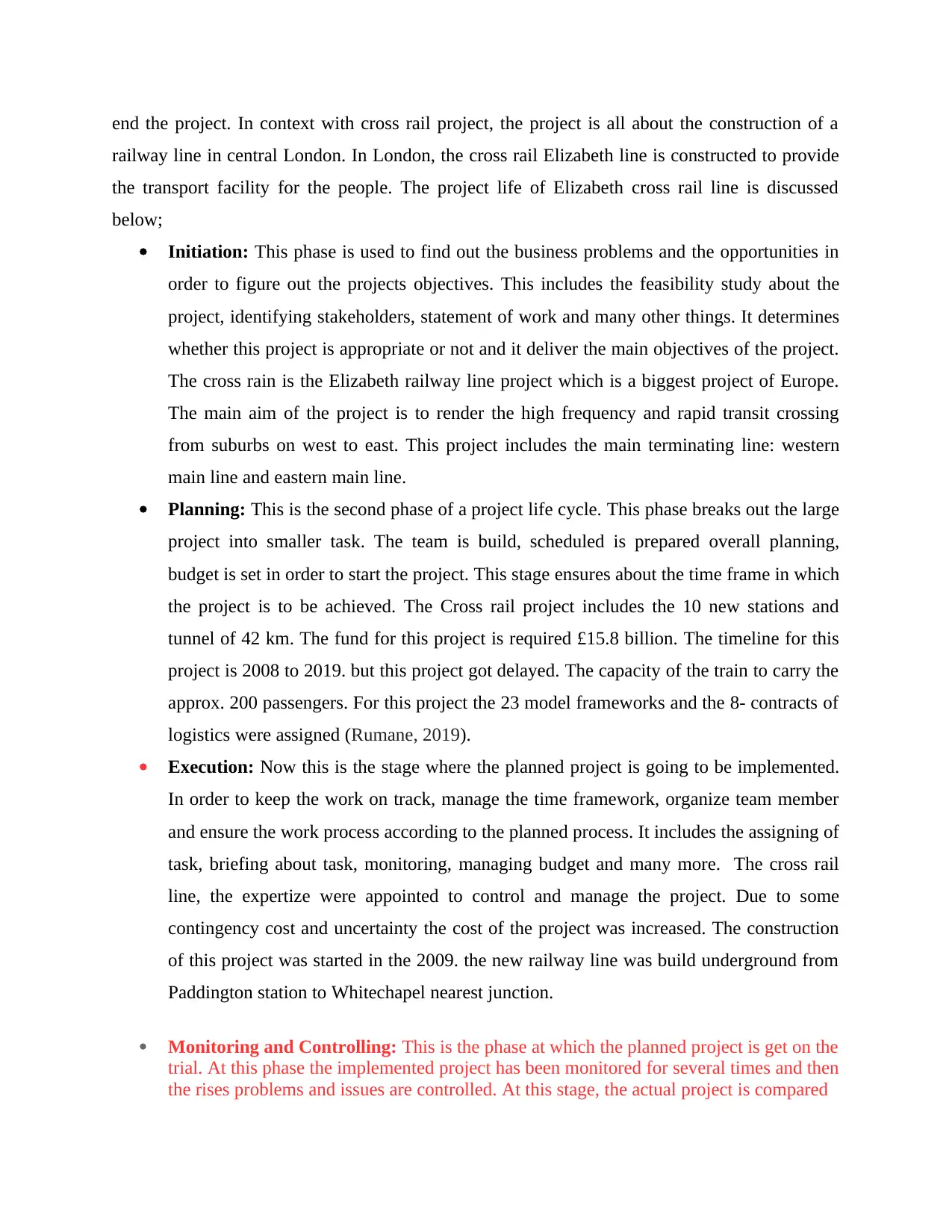
end the project. In context with cross rail project, the project is all about the construction of a
railway line in central London. In London, the cross rail Elizabeth line is constructed to provide
the transport facility for the people. The project life of Elizabeth cross rail line is discussed
below;
Initiation: This phase is used to find out the business problems and the opportunities in
order to figure out the projects objectives. This includes the feasibility study about the
project, identifying stakeholders, statement of work and many other things. It determines
whether this project is appropriate or not and it deliver the main objectives of the project.
The cross rain is the Elizabeth railway line project which is a biggest project of Europe.
The main aim of the project is to render the high frequency and rapid transit crossing
from suburbs on west to east. This project includes the main terminating line: western
main line and eastern main line.
Planning: This is the second phase of a project life cycle. This phase breaks out the large
project into smaller task. The team is build, scheduled is prepared overall planning,
budget is set in order to start the project. This stage ensures about the time frame in which
the project is to be achieved. The Cross rail project includes the 10 new stations and
tunnel of 42 km. The fund for this project is required £15.8 billion. The timeline for this
project is 2008 to 2019. but this project got delayed. The capacity of the train to carry the
approx. 200 passengers. For this project the 23 model frameworks and the 8- contracts of
logistics were assigned (Rumane, 2019).
Execution: Now this is the stage where the planned project is going to be implemented.
In order to keep the work on track, manage the time framework, organize team member
and ensure the work process according to the planned process. It includes the assigning of
task, briefing about task, monitoring, managing budget and many more. The cross rail
line, the expertize were appointed to control and manage the project. Due to some
contingency cost and uncertainty the cost of the project was increased. The construction
of this project was started in the 2009. the new railway line was build underground from
Paddington station to Whitechapel nearest junction.
Monitoring and Controlling: This is the phase at which the planned project is get on the
trial. At this phase the implemented project has been monitored for several times and then
the rises problems and issues are controlled. At this stage, the actual project is compared
railway line in central London. In London, the cross rail Elizabeth line is constructed to provide
the transport facility for the people. The project life of Elizabeth cross rail line is discussed
below;
Initiation: This phase is used to find out the business problems and the opportunities in
order to figure out the projects objectives. This includes the feasibility study about the
project, identifying stakeholders, statement of work and many other things. It determines
whether this project is appropriate or not and it deliver the main objectives of the project.
The cross rain is the Elizabeth railway line project which is a biggest project of Europe.
The main aim of the project is to render the high frequency and rapid transit crossing
from suburbs on west to east. This project includes the main terminating line: western
main line and eastern main line.
Planning: This is the second phase of a project life cycle. This phase breaks out the large
project into smaller task. The team is build, scheduled is prepared overall planning,
budget is set in order to start the project. This stage ensures about the time frame in which
the project is to be achieved. The Cross rail project includes the 10 new stations and
tunnel of 42 km. The fund for this project is required £15.8 billion. The timeline for this
project is 2008 to 2019. but this project got delayed. The capacity of the train to carry the
approx. 200 passengers. For this project the 23 model frameworks and the 8- contracts of
logistics were assigned (Rumane, 2019).
Execution: Now this is the stage where the planned project is going to be implemented.
In order to keep the work on track, manage the time framework, organize team member
and ensure the work process according to the planned process. It includes the assigning of
task, briefing about task, monitoring, managing budget and many more. The cross rail
line, the expertize were appointed to control and manage the project. Due to some
contingency cost and uncertainty the cost of the project was increased. The construction
of this project was started in the 2009. the new railway line was build underground from
Paddington station to Whitechapel nearest junction.
Monitoring and Controlling: This is the phase at which the planned project is get on the
trial. At this phase the implemented project has been monitored for several times and then
the rises problems and issues are controlled. At this stage, the actual project is compared
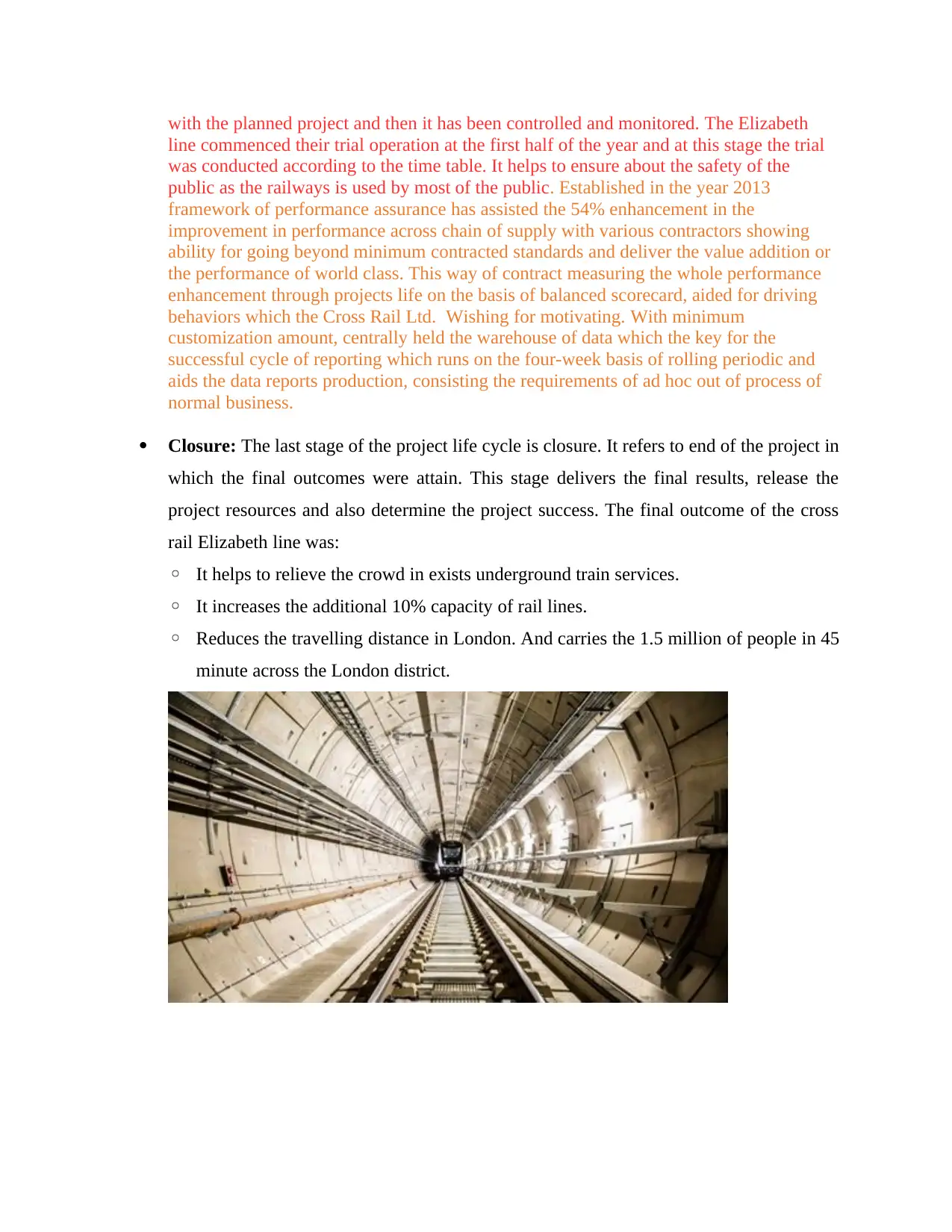
with the planned project and then it has been controlled and monitored. The Elizabeth
line commenced their trial operation at the first half of the year and at this stage the trial
was conducted according to the time table. It helps to ensure about the safety of the
public as the railways is used by most of the public. Established in the year 2013
framework of performance assurance has assisted the 54% enhancement in the
improvement in performance across chain of supply with various contractors showing
ability for going beyond minimum contracted standards and deliver the value addition or
the performance of world class. This way of contract measuring the whole performance
enhancement through projects life on the basis of balanced scorecard, aided for driving
behaviors which the Cross Rail Ltd. Wishing for motivating. With minimum
customization amount, centrally held the warehouse of data which the key for the
successful cycle of reporting which runs on the four-week basis of rolling periodic and
aids the data reports production, consisting the requirements of ad hoc out of process of
normal business.
Closure: The last stage of the project life cycle is closure. It refers to end of the project in
which the final outcomes were attain. This stage delivers the final results, release the
project resources and also determine the project success. The final outcome of the cross
rail Elizabeth line was:
◦ It helps to relieve the crowd in exists underground train services.
◦ It increases the additional 10% capacity of rail lines.
◦ Reduces the travelling distance in London. And carries the 1.5 million of people in 45
minute across the London district.
line commenced their trial operation at the first half of the year and at this stage the trial
was conducted according to the time table. It helps to ensure about the safety of the
public as the railways is used by most of the public. Established in the year 2013
framework of performance assurance has assisted the 54% enhancement in the
improvement in performance across chain of supply with various contractors showing
ability for going beyond minimum contracted standards and deliver the value addition or
the performance of world class. This way of contract measuring the whole performance
enhancement through projects life on the basis of balanced scorecard, aided for driving
behaviors which the Cross Rail Ltd. Wishing for motivating. With minimum
customization amount, centrally held the warehouse of data which the key for the
successful cycle of reporting which runs on the four-week basis of rolling periodic and
aids the data reports production, consisting the requirements of ad hoc out of process of
normal business.
Closure: The last stage of the project life cycle is closure. It refers to end of the project in
which the final outcomes were attain. This stage delivers the final results, release the
project resources and also determine the project success. The final outcome of the cross
rail Elizabeth line was:
◦ It helps to relieve the crowd in exists underground train services.
◦ It increases the additional 10% capacity of rail lines.
◦ Reduces the travelling distance in London. And carries the 1.5 million of people in 45
minute across the London district.
Paraphrase This Document
Need a fresh take? Get an instant paraphrase of this document with our AI Paraphraser
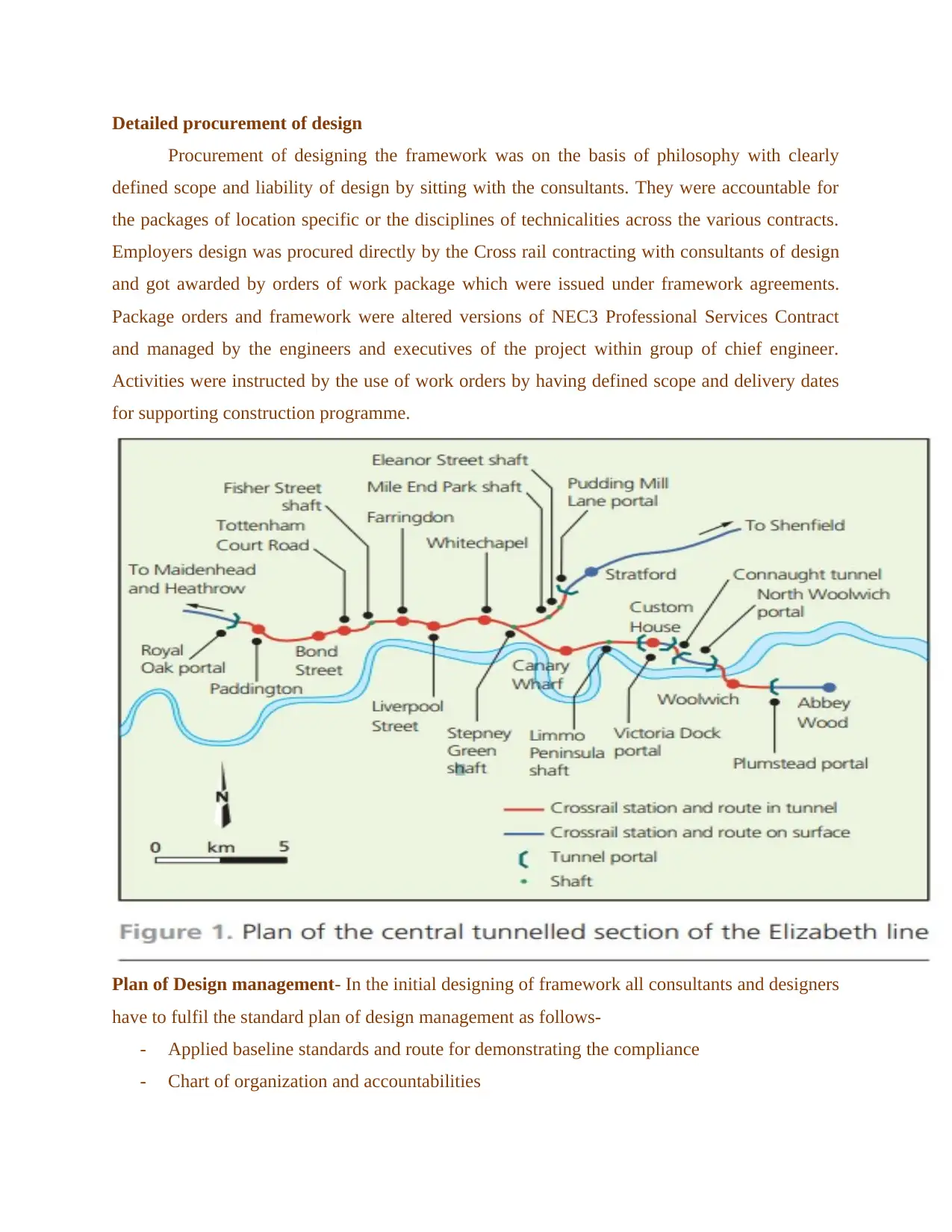
Detailed procurement of design
Procurement of designing the framework was on the basis of philosophy with clearly
defined scope and liability of design by sitting with the consultants. They were accountable for
the packages of location specific or the disciplines of technicalities across the various contracts.
Employers design was procured directly by the Cross rail contracting with consultants of design
and got awarded by orders of work package which were issued under framework agreements.
Package orders and framework were altered versions of NEC3 Professional Services Contract
and managed by the engineers and executives of the project within group of chief engineer.
Activities were instructed by the use of work orders by having defined scope and delivery dates
for supporting construction programme.
Plan of Design management- In the initial designing of framework all consultants and designers
have to fulfil the standard plan of design management as follows-
- Applied baseline standards and route for demonstrating the compliance
- Chart of organization and accountabilities
Procurement of designing the framework was on the basis of philosophy with clearly
defined scope and liability of design by sitting with the consultants. They were accountable for
the packages of location specific or the disciplines of technicalities across the various contracts.
Employers design was procured directly by the Cross rail contracting with consultants of design
and got awarded by orders of work package which were issued under framework agreements.
Package orders and framework were altered versions of NEC3 Professional Services Contract
and managed by the engineers and executives of the project within group of chief engineer.
Activities were instructed by the use of work orders by having defined scope and delivery dates
for supporting construction programme.
Plan of Design management- In the initial designing of framework all consultants and designers
have to fulfil the standard plan of design management as follows-
- Applied baseline standards and route for demonstrating the compliance
- Chart of organization and accountabilities
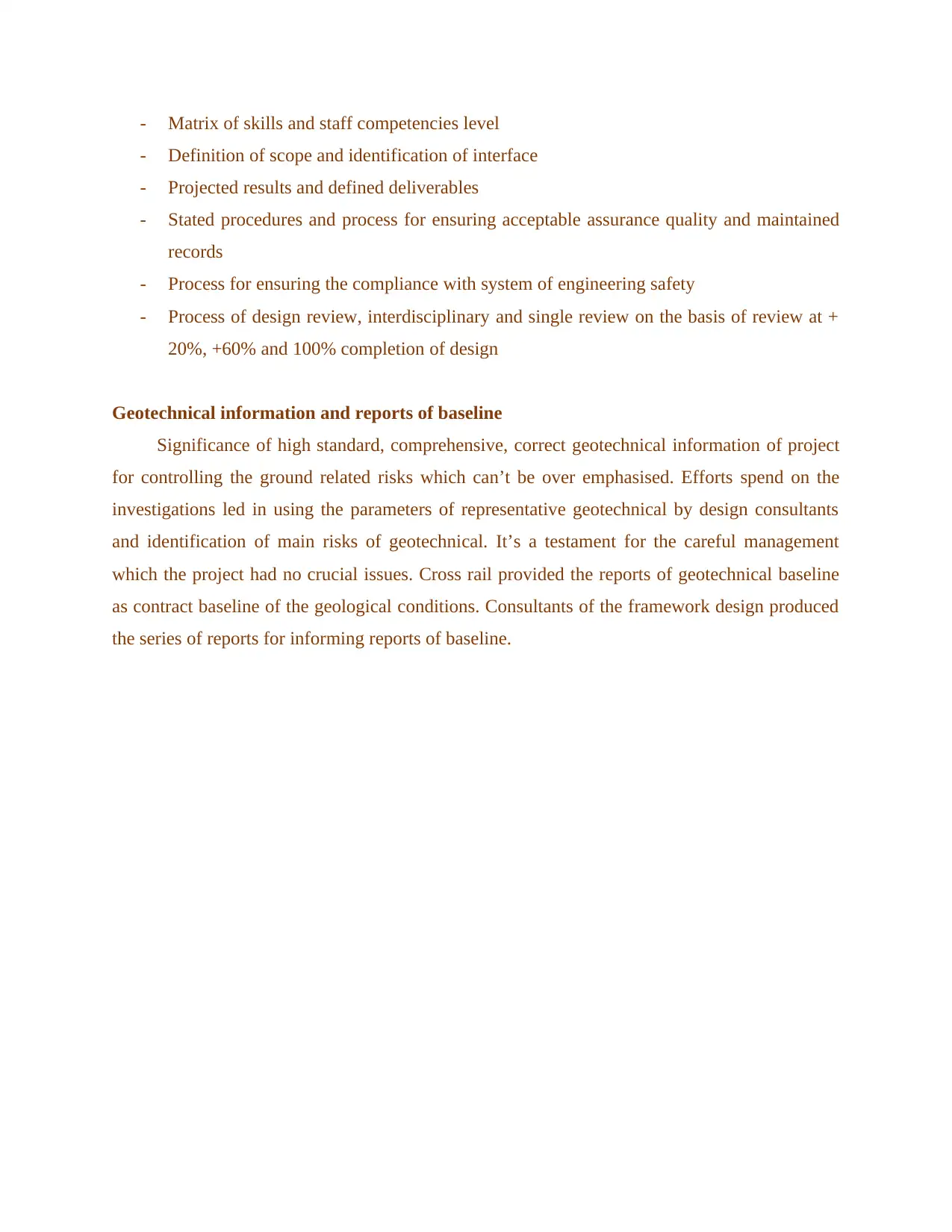
- Matrix of skills and staff competencies level
- Definition of scope and identification of interface
- Projected results and defined deliverables
- Stated procedures and process for ensuring acceptable assurance quality and maintained
records
- Process for ensuring the compliance with system of engineering safety
- Process of design review, interdisciplinary and single review on the basis of review at +
20%, +60% and 100% completion of design
Geotechnical information and reports of baseline
Significance of high standard, comprehensive, correct geotechnical information of project
for controlling the ground related risks which can’t be over emphasised. Efforts spend on the
investigations led in using the parameters of representative geotechnical by design consultants
and identification of main risks of geotechnical. It’s a testament for the careful management
which the project had no crucial issues. Cross rail provided the reports of geotechnical baseline
as contract baseline of the geological conditions. Consultants of the framework design produced
the series of reports for informing reports of baseline.
- Definition of scope and identification of interface
- Projected results and defined deliverables
- Stated procedures and process for ensuring acceptable assurance quality and maintained
records
- Process for ensuring the compliance with system of engineering safety
- Process of design review, interdisciplinary and single review on the basis of review at +
20%, +60% and 100% completion of design
Geotechnical information and reports of baseline
Significance of high standard, comprehensive, correct geotechnical information of project
for controlling the ground related risks which can’t be over emphasised. Efforts spend on the
investigations led in using the parameters of representative geotechnical by design consultants
and identification of main risks of geotechnical. It’s a testament for the careful management
which the project had no crucial issues. Cross rail provided the reports of geotechnical baseline
as contract baseline of the geological conditions. Consultants of the framework design produced
the series of reports for informing reports of baseline.
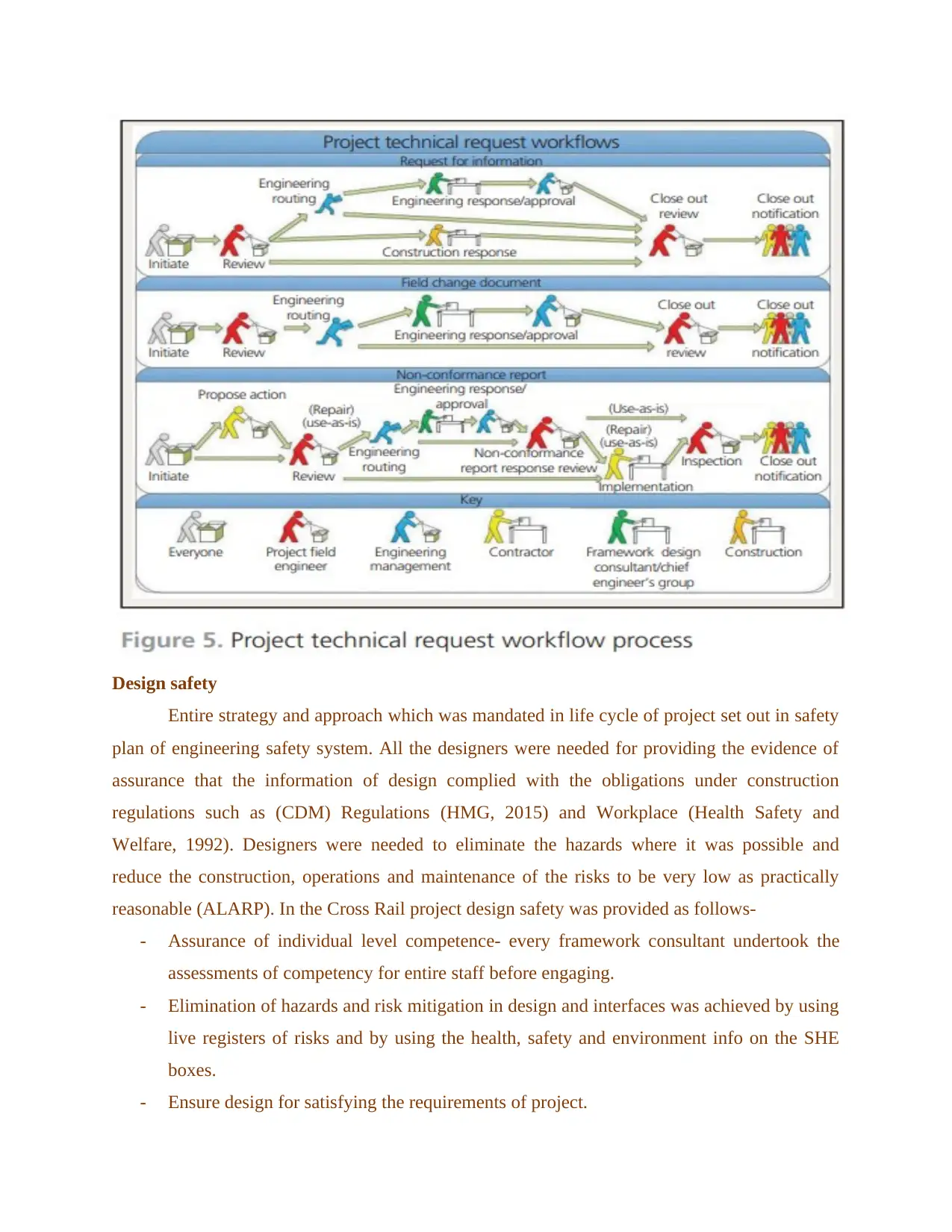
Design safety
Entire strategy and approach which was mandated in life cycle of project set out in safety
plan of engineering safety system. All the designers were needed for providing the evidence of
assurance that the information of design complied with the obligations under construction
regulations such as (CDM) Regulations (HMG, 2015) and Workplace (Health Safety and
Welfare, 1992). Designers were needed to eliminate the hazards where it was possible and
reduce the construction, operations and maintenance of the risks to be very low as practically
reasonable (ALARP). In the Cross Rail project design safety was provided as follows-
- Assurance of individual level competence- every framework consultant undertook the
assessments of competency for entire staff before engaging.
- Elimination of hazards and risk mitigation in design and interfaces was achieved by using
live registers of risks and by using the health, safety and environment info on the SHE
boxes.
- Ensure design for satisfying the requirements of project.
Entire strategy and approach which was mandated in life cycle of project set out in safety
plan of engineering safety system. All the designers were needed for providing the evidence of
assurance that the information of design complied with the obligations under construction
regulations such as (CDM) Regulations (HMG, 2015) and Workplace (Health Safety and
Welfare, 1992). Designers were needed to eliminate the hazards where it was possible and
reduce the construction, operations and maintenance of the risks to be very low as practically
reasonable (ALARP). In the Cross Rail project design safety was provided as follows-
- Assurance of individual level competence- every framework consultant undertook the
assessments of competency for entire staff before engaging.
- Elimination of hazards and risk mitigation in design and interfaces was achieved by using
live registers of risks and by using the health, safety and environment info on the SHE
boxes.
- Ensure design for satisfying the requirements of project.
Secure Best Marks with AI Grader
Need help grading? Try our AI Grader for instant feedback on your assignments.
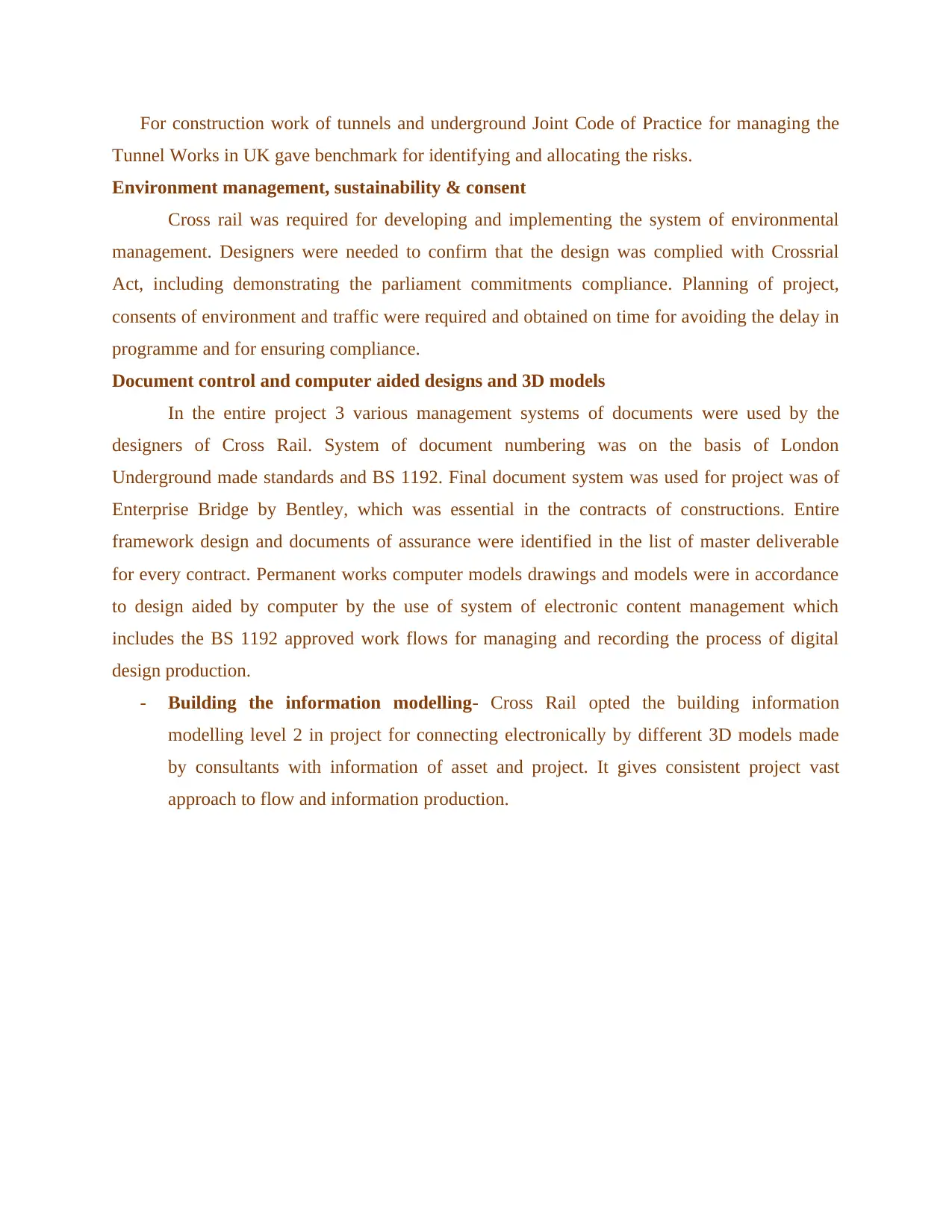
For construction work of tunnels and underground Joint Code of Practice for managing the
Tunnel Works in UK gave benchmark for identifying and allocating the risks.
Environment management, sustainability & consent
Cross rail was required for developing and implementing the system of environmental
management. Designers were needed to confirm that the design was complied with Crossrial
Act, including demonstrating the parliament commitments compliance. Planning of project,
consents of environment and traffic were required and obtained on time for avoiding the delay in
programme and for ensuring compliance.
Document control and computer aided designs and 3D models
In the entire project 3 various management systems of documents were used by the
designers of Cross Rail. System of document numbering was on the basis of London
Underground made standards and BS 1192. Final document system was used for project was of
Enterprise Bridge by Bentley, which was essential in the contracts of constructions. Entire
framework design and documents of assurance were identified in the list of master deliverable
for every contract. Permanent works computer models drawings and models were in accordance
to design aided by computer by the use of system of electronic content management which
includes the BS 1192 approved work flows for managing and recording the process of digital
design production.
- Building the information modelling- Cross Rail opted the building information
modelling level 2 in project for connecting electronically by different 3D models made
by consultants with information of asset and project. It gives consistent project vast
approach to flow and information production.
Tunnel Works in UK gave benchmark for identifying and allocating the risks.
Environment management, sustainability & consent
Cross rail was required for developing and implementing the system of environmental
management. Designers were needed to confirm that the design was complied with Crossrial
Act, including demonstrating the parliament commitments compliance. Planning of project,
consents of environment and traffic were required and obtained on time for avoiding the delay in
programme and for ensuring compliance.
Document control and computer aided designs and 3D models
In the entire project 3 various management systems of documents were used by the
designers of Cross Rail. System of document numbering was on the basis of London
Underground made standards and BS 1192. Final document system was used for project was of
Enterprise Bridge by Bentley, which was essential in the contracts of constructions. Entire
framework design and documents of assurance were identified in the list of master deliverable
for every contract. Permanent works computer models drawings and models were in accordance
to design aided by computer by the use of system of electronic content management which
includes the BS 1192 approved work flows for managing and recording the process of digital
design production.
- Building the information modelling- Cross Rail opted the building information
modelling level 2 in project for connecting electronically by different 3D models made
by consultants with information of asset and project. It gives consistent project vast
approach to flow and information production.
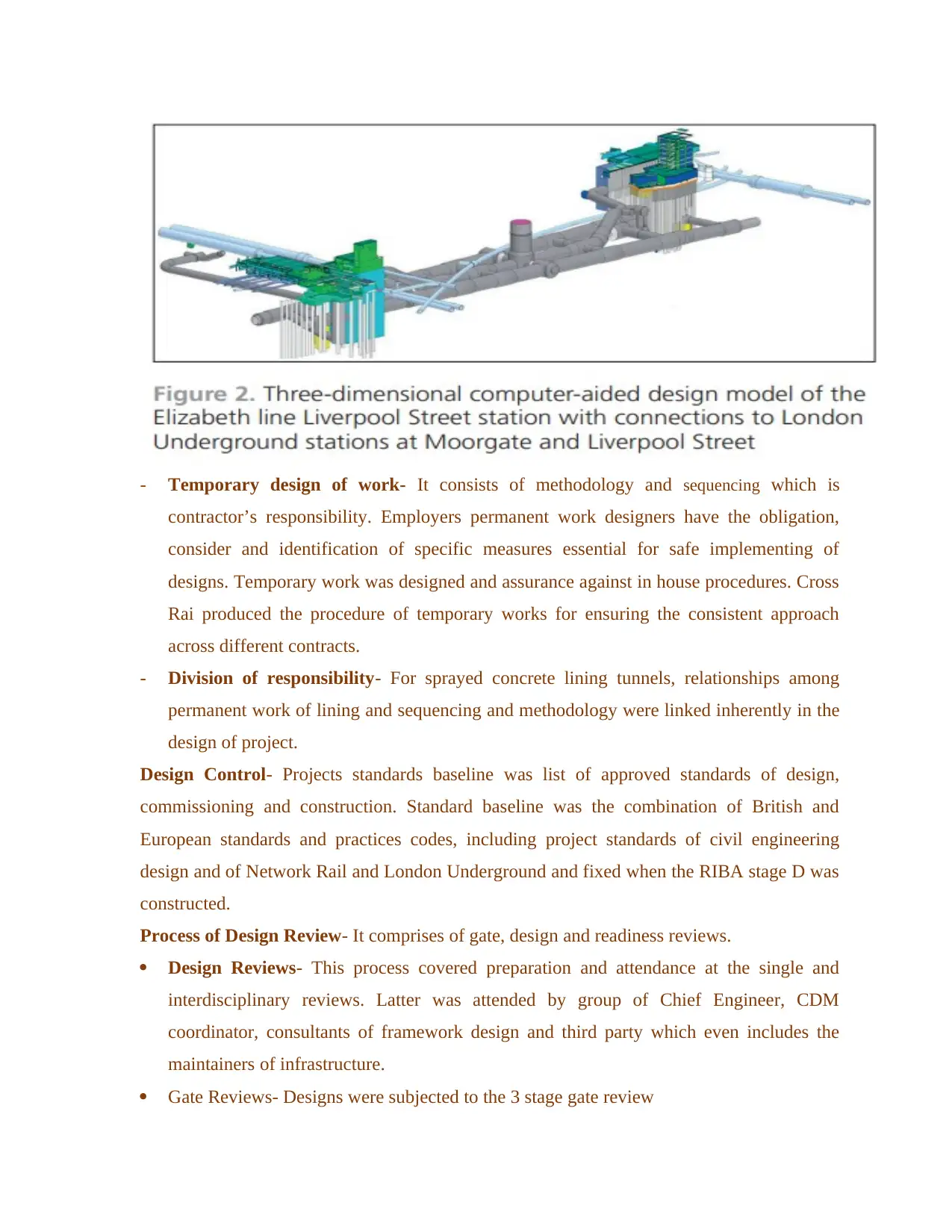
- Temporary design of work- It consists of methodology and sequencing which is
contractor’s responsibility. Employers permanent work designers have the obligation,
consider and identification of specific measures essential for safe implementing of
designs. Temporary work was designed and assurance against in house procedures. Cross
Rai produced the procedure of temporary works for ensuring the consistent approach
across different contracts.
- Division of responsibility- For sprayed concrete lining tunnels, relationships among
permanent work of lining and sequencing and methodology were linked inherently in the
design of project.
Design Control- Projects standards baseline was list of approved standards of design,
commissioning and construction. Standard baseline was the combination of British and
European standards and practices codes, including project standards of civil engineering
design and of Network Rail and London Underground and fixed when the RIBA stage D was
constructed.
Process of Design Review- It comprises of gate, design and readiness reviews.
Design Reviews- This process covered preparation and attendance at the single and
interdisciplinary reviews. Latter was attended by group of Chief Engineer, CDM
coordinator, consultants of framework design and third party which even includes the
maintainers of infrastructure.
Gate Reviews- Designs were subjected to the 3 stage gate review
contractor’s responsibility. Employers permanent work designers have the obligation,
consider and identification of specific measures essential for safe implementing of
designs. Temporary work was designed and assurance against in house procedures. Cross
Rai produced the procedure of temporary works for ensuring the consistent approach
across different contracts.
- Division of responsibility- For sprayed concrete lining tunnels, relationships among
permanent work of lining and sequencing and methodology were linked inherently in the
design of project.
Design Control- Projects standards baseline was list of approved standards of design,
commissioning and construction. Standard baseline was the combination of British and
European standards and practices codes, including project standards of civil engineering
design and of Network Rail and London Underground and fixed when the RIBA stage D was
constructed.
Process of Design Review- It comprises of gate, design and readiness reviews.
Design Reviews- This process covered preparation and attendance at the single and
interdisciplinary reviews. Latter was attended by group of Chief Engineer, CDM
coordinator, consultants of framework design and third party which even includes the
maintainers of infrastructure.
Gate Reviews- Designs were subjected to the 3 stage gate review
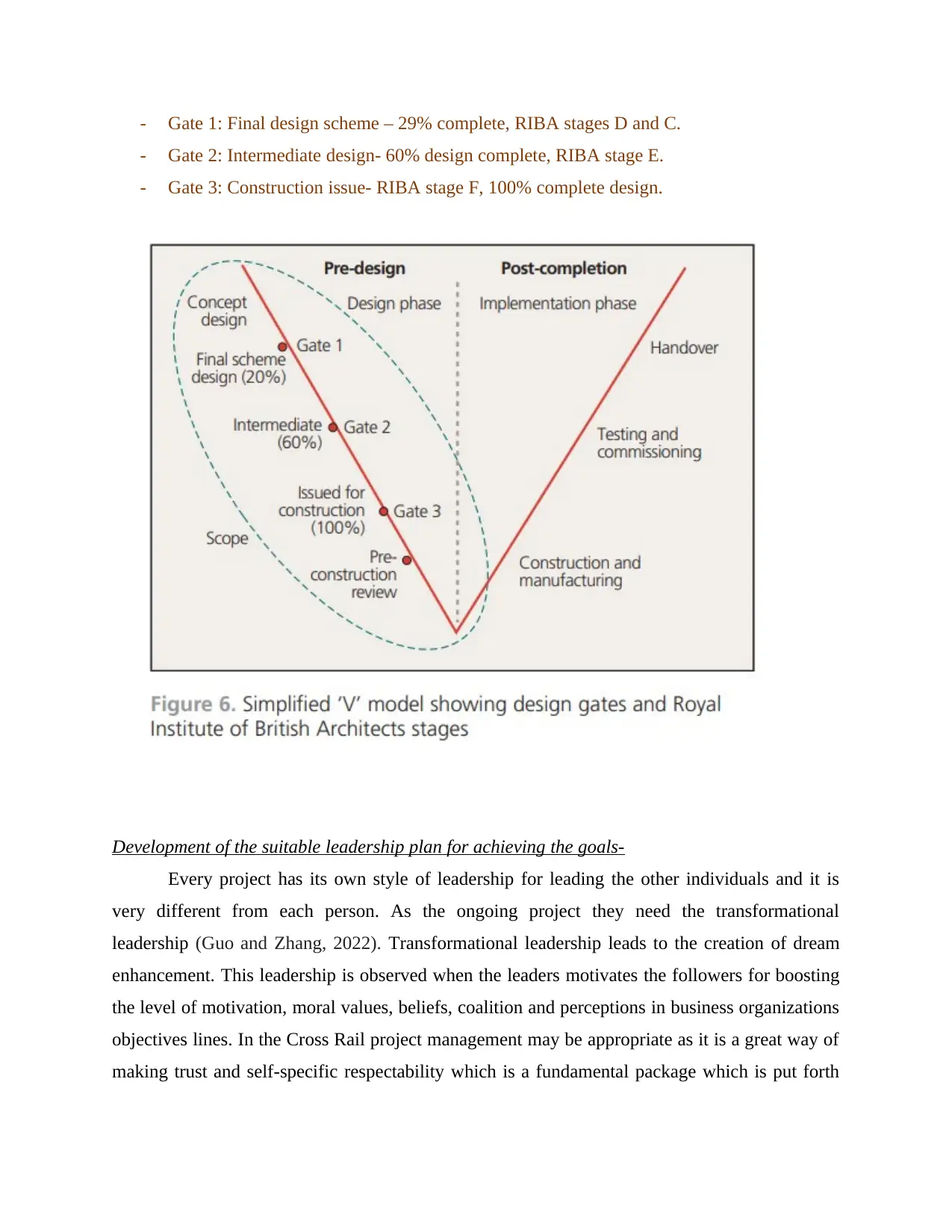
- Gate 1: Final design scheme – 29% complete, RIBA stages D and C.
- Gate 2: Intermediate design- 60% design complete, RIBA stage E.
- Gate 3: Construction issue- RIBA stage F, 100% complete design.
Development of the suitable leadership plan for achieving the goals-
Every project has its own style of leadership for leading the other individuals and it is
very different from each person. As the ongoing project they need the transformational
leadership (Guo and Zhang, 2022). Transformational leadership leads to the creation of dream
enhancement. This leadership is observed when the leaders motivates the followers for boosting
the level of motivation, moral values, beliefs, coalition and perceptions in business organizations
objectives lines. In the Cross Rail project management may be appropriate as it is a great way of
making trust and self-specific respectability which is a fundamental package which is put forth
- Gate 2: Intermediate design- 60% design complete, RIBA stage E.
- Gate 3: Construction issue- RIBA stage F, 100% complete design.
Development of the suitable leadership plan for achieving the goals-
Every project has its own style of leadership for leading the other individuals and it is
very different from each person. As the ongoing project they need the transformational
leadership (Guo and Zhang, 2022). Transformational leadership leads to the creation of dream
enhancement. This leadership is observed when the leaders motivates the followers for boosting
the level of motivation, moral values, beliefs, coalition and perceptions in business organizations
objectives lines. In the Cross Rail project management may be appropriate as it is a great way of
making trust and self-specific respectability which is a fundamental package which is put forth
Paraphrase This Document
Need a fresh take? Get an instant paraphrase of this document with our AI Paraphraser
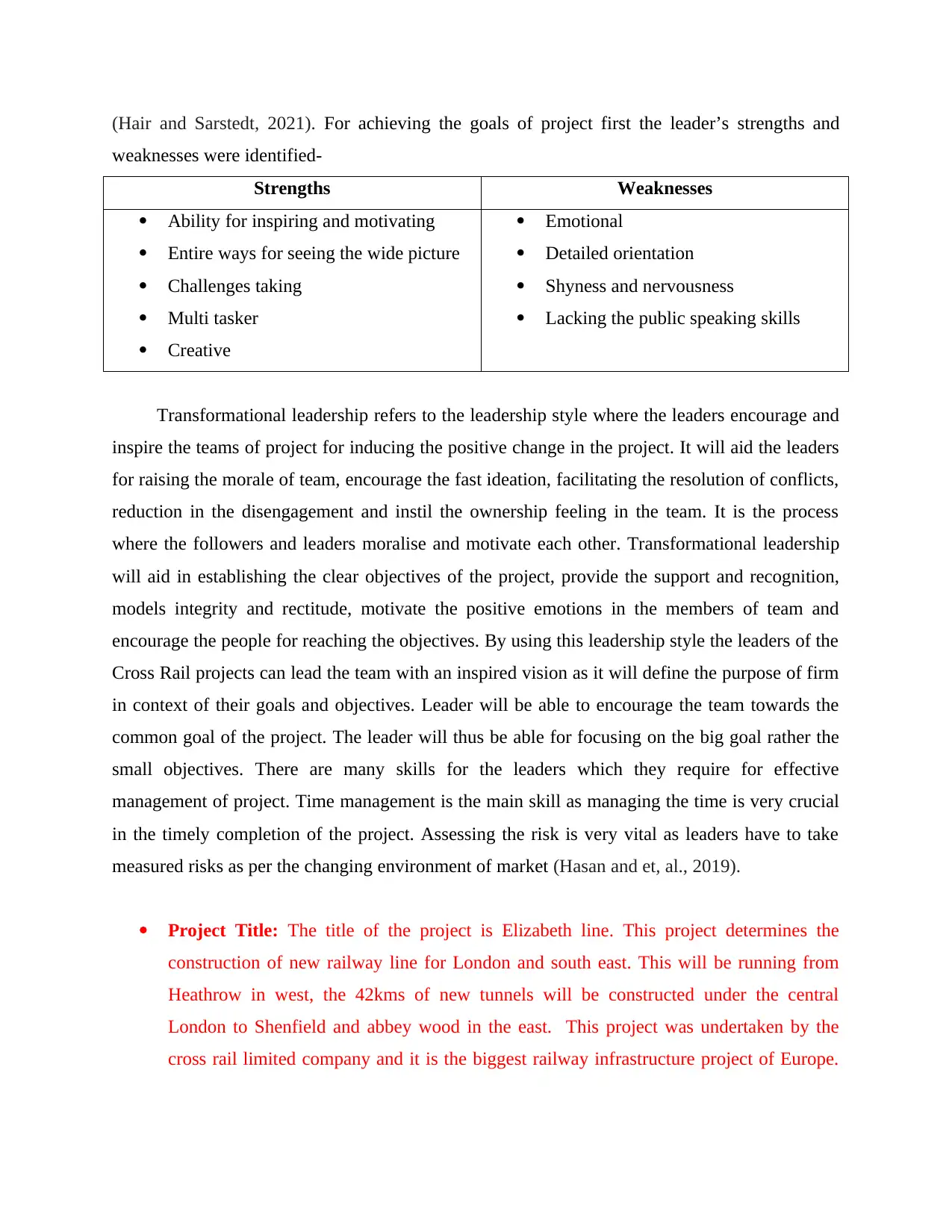
(Hair and Sarstedt, 2021). For achieving the goals of project first the leader’s strengths and
weaknesses were identified-
Strengths Weaknesses
Ability for inspiring and motivating
Entire ways for seeing the wide picture
Challenges taking
Multi tasker
Creative
Emotional
Detailed orientation
Shyness and nervousness
Lacking the public speaking skills
Transformational leadership refers to the leadership style where the leaders encourage and
inspire the teams of project for inducing the positive change in the project. It will aid the leaders
for raising the morale of team, encourage the fast ideation, facilitating the resolution of conflicts,
reduction in the disengagement and instil the ownership feeling in the team. It is the process
where the followers and leaders moralise and motivate each other. Transformational leadership
will aid in establishing the clear objectives of the project, provide the support and recognition,
models integrity and rectitude, motivate the positive emotions in the members of team and
encourage the people for reaching the objectives. By using this leadership style the leaders of the
Cross Rail projects can lead the team with an inspired vision as it will define the purpose of firm
in context of their goals and objectives. Leader will be able to encourage the team towards the
common goal of the project. The leader will thus be able for focusing on the big goal rather the
small objectives. There are many skills for the leaders which they require for effective
management of project. Time management is the main skill as managing the time is very crucial
in the timely completion of the project. Assessing the risk is very vital as leaders have to take
measured risks as per the changing environment of market (Hasan and et, al., 2019).
Project Title: The title of the project is Elizabeth line. This project determines the
construction of new railway line for London and south east. This will be running from
Heathrow in west, the 42kms of new tunnels will be constructed under the central
London to Shenfield and abbey wood in the east. This project was undertaken by the
cross rail limited company and it is the biggest railway infrastructure project of Europe.
weaknesses were identified-
Strengths Weaknesses
Ability for inspiring and motivating
Entire ways for seeing the wide picture
Challenges taking
Multi tasker
Creative
Emotional
Detailed orientation
Shyness and nervousness
Lacking the public speaking skills
Transformational leadership refers to the leadership style where the leaders encourage and
inspire the teams of project for inducing the positive change in the project. It will aid the leaders
for raising the morale of team, encourage the fast ideation, facilitating the resolution of conflicts,
reduction in the disengagement and instil the ownership feeling in the team. It is the process
where the followers and leaders moralise and motivate each other. Transformational leadership
will aid in establishing the clear objectives of the project, provide the support and recognition,
models integrity and rectitude, motivate the positive emotions in the members of team and
encourage the people for reaching the objectives. By using this leadership style the leaders of the
Cross Rail projects can lead the team with an inspired vision as it will define the purpose of firm
in context of their goals and objectives. Leader will be able to encourage the team towards the
common goal of the project. The leader will thus be able for focusing on the big goal rather the
small objectives. There are many skills for the leaders which they require for effective
management of project. Time management is the main skill as managing the time is very crucial
in the timely completion of the project. Assessing the risk is very vital as leaders have to take
measured risks as per the changing environment of market (Hasan and et, al., 2019).
Project Title: The title of the project is Elizabeth line. This project determines the
construction of new railway line for London and south east. This will be running from
Heathrow in west, the 42kms of new tunnels will be constructed under the central
London to Shenfield and abbey wood in the east. This project was undertaken by the
cross rail limited company and it is the biggest railway infrastructure project of Europe.
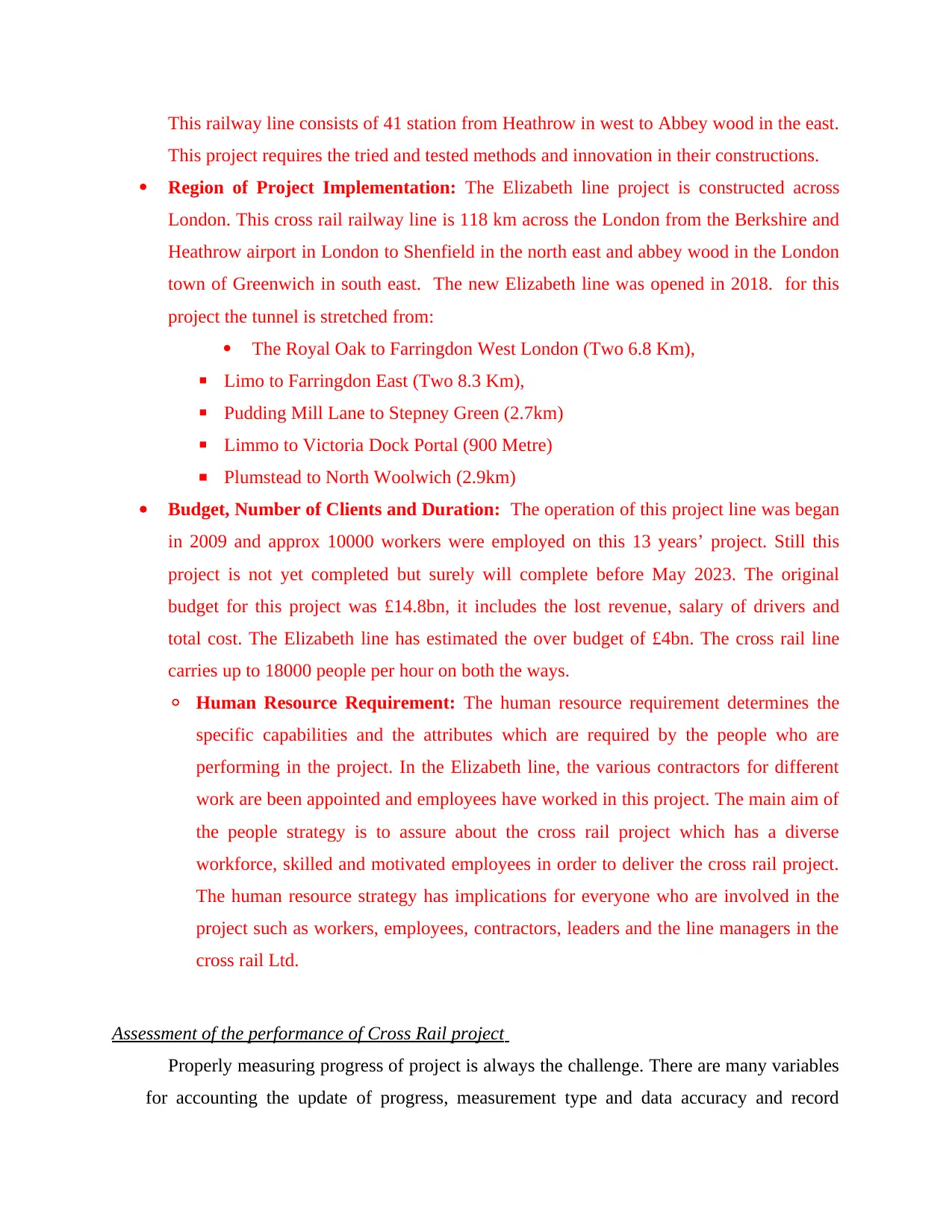
This railway line consists of 41 station from Heathrow in west to Abbey wood in the east.
This project requires the tried and tested methods and innovation in their constructions.
Region of Project Implementation: The Elizabeth line project is constructed across
London. This cross rail railway line is 118 km across the London from the Berkshire and
Heathrow airport in London to Shenfield in the north east and abbey wood in the London
town of Greenwich in south east. The new Elizabeth line was opened in 2018. for this
project the tunnel is stretched from:
The Royal Oak to Farringdon West London (Two 6.8 Km),
▪ Limo to Farringdon East (Two 8.3 Km),
▪ Pudding Mill Lane to Stepney Green (2.7km)
▪ Limmo to Victoria Dock Portal (900 Metre)
▪ Plumstead to North Woolwich (2.9km)
Budget, Number of Clients and Duration: The operation of this project line was began
in 2009 and approx 10000 workers were employed on this 13 years’ project. Still this
project is not yet completed but surely will complete before May 2023. The original
budget for this project was £14.8bn, it includes the lost revenue, salary of drivers and
total cost. The Elizabeth line has estimated the over budget of £4bn. The cross rail line
carries up to 18000 people per hour on both the ways.
◦ Human Resource Requirement: The human resource requirement determines the
specific capabilities and the attributes which are required by the people who are
performing in the project. In the Elizabeth line, the various contractors for different
work are been appointed and employees have worked in this project. The main aim of
the people strategy is to assure about the cross rail project which has a diverse
workforce, skilled and motivated employees in order to deliver the cross rail project.
The human resource strategy has implications for everyone who are involved in the
project such as workers, employees, contractors, leaders and the line managers in the
cross rail Ltd.
Assessment of the performance of Cross Rail project
Properly measuring progress of project is always the challenge. There are many variables
for accounting the update of progress, measurement type and data accuracy and record
This project requires the tried and tested methods and innovation in their constructions.
Region of Project Implementation: The Elizabeth line project is constructed across
London. This cross rail railway line is 118 km across the London from the Berkshire and
Heathrow airport in London to Shenfield in the north east and abbey wood in the London
town of Greenwich in south east. The new Elizabeth line was opened in 2018. for this
project the tunnel is stretched from:
The Royal Oak to Farringdon West London (Two 6.8 Km),
▪ Limo to Farringdon East (Two 8.3 Km),
▪ Pudding Mill Lane to Stepney Green (2.7km)
▪ Limmo to Victoria Dock Portal (900 Metre)
▪ Plumstead to North Woolwich (2.9km)
Budget, Number of Clients and Duration: The operation of this project line was began
in 2009 and approx 10000 workers were employed on this 13 years’ project. Still this
project is not yet completed but surely will complete before May 2023. The original
budget for this project was £14.8bn, it includes the lost revenue, salary of drivers and
total cost. The Elizabeth line has estimated the over budget of £4bn. The cross rail line
carries up to 18000 people per hour on both the ways.
◦ Human Resource Requirement: The human resource requirement determines the
specific capabilities and the attributes which are required by the people who are
performing in the project. In the Elizabeth line, the various contractors for different
work are been appointed and employees have worked in this project. The main aim of
the people strategy is to assure about the cross rail project which has a diverse
workforce, skilled and motivated employees in order to deliver the cross rail project.
The human resource strategy has implications for everyone who are involved in the
project such as workers, employees, contractors, leaders and the line managers in the
cross rail Ltd.
Assessment of the performance of Cross Rail project
Properly measuring progress of project is always the challenge. There are many variables
for accounting the update of progress, measurement type and data accuracy and record
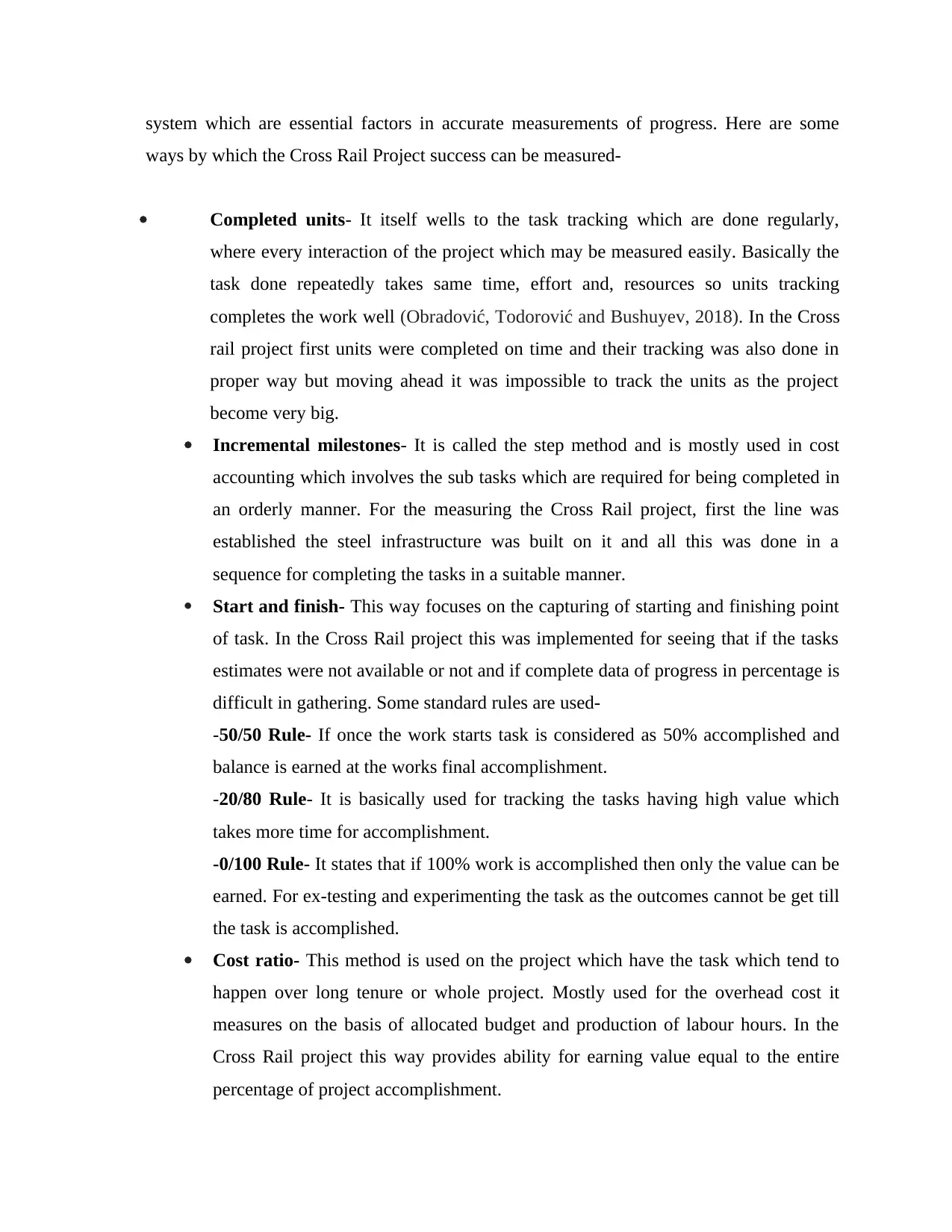
system which are essential factors in accurate measurements of progress. Here are some
ways by which the Cross Rail Project success can be measured-
Completed units- It itself wells to the task tracking which are done regularly,
where every interaction of the project which may be measured easily. Basically the
task done repeatedly takes same time, effort and, resources so units tracking
completes the work well (Obradović, Todorović and Bushuyev, 2018). In the Cross
rail project first units were completed on time and their tracking was also done in
proper way but moving ahead it was impossible to track the units as the project
become very big.
Incremental milestones- It is called the step method and is mostly used in cost
accounting which involves the sub tasks which are required for being completed in
an orderly manner. For the measuring the Cross Rail project, first the line was
established the steel infrastructure was built on it and all this was done in a
sequence for completing the tasks in a suitable manner.
Start and finish- This way focuses on the capturing of starting and finishing point
of task. In the Cross Rail project this was implemented for seeing that if the tasks
estimates were not available or not and if complete data of progress in percentage is
difficult in gathering. Some standard rules are used-
-50/50 Rule- If once the work starts task is considered as 50% accomplished and
balance is earned at the works final accomplishment.
-20/80 Rule- It is basically used for tracking the tasks having high value which
takes more time for accomplishment.
-0/100 Rule- It states that if 100% work is accomplished then only the value can be
earned. For ex-testing and experimenting the task as the outcomes cannot be get till
the task is accomplished.
Cost ratio- This method is used on the project which have the task which tend to
happen over long tenure or whole project. Mostly used for the overhead cost it
measures on the basis of allocated budget and production of labour hours. In the
Cross Rail project this way provides ability for earning value equal to the entire
percentage of project accomplishment.
ways by which the Cross Rail Project success can be measured-
Completed units- It itself wells to the task tracking which are done regularly,
where every interaction of the project which may be measured easily. Basically the
task done repeatedly takes same time, effort and, resources so units tracking
completes the work well (Obradović, Todorović and Bushuyev, 2018). In the Cross
rail project first units were completed on time and their tracking was also done in
proper way but moving ahead it was impossible to track the units as the project
become very big.
Incremental milestones- It is called the step method and is mostly used in cost
accounting which involves the sub tasks which are required for being completed in
an orderly manner. For the measuring the Cross Rail project, first the line was
established the steel infrastructure was built on it and all this was done in a
sequence for completing the tasks in a suitable manner.
Start and finish- This way focuses on the capturing of starting and finishing point
of task. In the Cross Rail project this was implemented for seeing that if the tasks
estimates were not available or not and if complete data of progress in percentage is
difficult in gathering. Some standard rules are used-
-50/50 Rule- If once the work starts task is considered as 50% accomplished and
balance is earned at the works final accomplishment.
-20/80 Rule- It is basically used for tracking the tasks having high value which
takes more time for accomplishment.
-0/100 Rule- It states that if 100% work is accomplished then only the value can be
earned. For ex-testing and experimenting the task as the outcomes cannot be get till
the task is accomplished.
Cost ratio- This method is used on the project which have the task which tend to
happen over long tenure or whole project. Mostly used for the overhead cost it
measures on the basis of allocated budget and production of labour hours. In the
Cross Rail project this way provides ability for earning value equal to the entire
percentage of project accomplishment.
Secure Best Marks with AI Grader
Need help grading? Try our AI Grader for instant feedback on your assignments.
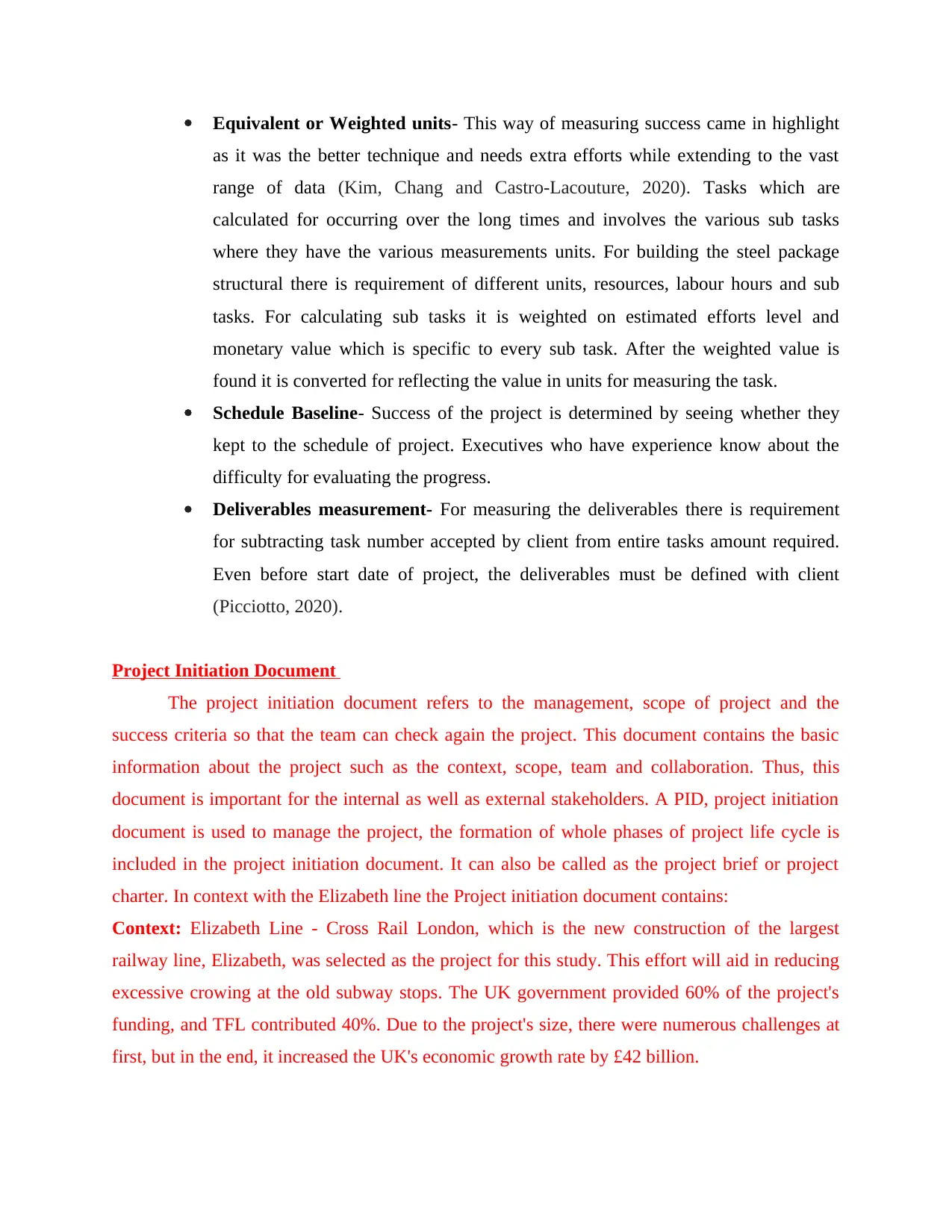
Equivalent or Weighted units- This way of measuring success came in highlight
as it was the better technique and needs extra efforts while extending to the vast
range of data (Kim, Chang and Castro-Lacouture, 2020). Tasks which are
calculated for occurring over the long times and involves the various sub tasks
where they have the various measurements units. For building the steel package
structural there is requirement of different units, resources, labour hours and sub
tasks. For calculating sub tasks it is weighted on estimated efforts level and
monetary value which is specific to every sub task. After the weighted value is
found it is converted for reflecting the value in units for measuring the task.
Schedule Baseline- Success of the project is determined by seeing whether they
kept to the schedule of project. Executives who have experience know about the
difficulty for evaluating the progress.
Deliverables measurement- For measuring the deliverables there is requirement
for subtracting task number accepted by client from entire tasks amount required.
Even before start date of project, the deliverables must be defined with client
(Picciotto, 2020).
Project Initiation Document
The project initiation document refers to the management, scope of project and the
success criteria so that the team can check again the project. This document contains the basic
information about the project such as the context, scope, team and collaboration. Thus, this
document is important for the internal as well as external stakeholders. A PID, project initiation
document is used to manage the project, the formation of whole phases of project life cycle is
included in the project initiation document. It can also be called as the project brief or project
charter. In context with the Elizabeth line the Project initiation document contains:
Context: Elizabeth Line - Cross Rail London, which is the new construction of the largest
railway line, Elizabeth, was selected as the project for this study. This effort will aid in reducing
excessive crowing at the old subway stops. The UK government provided 60% of the project's
funding, and TFL contributed 40%. Due to the project's size, there were numerous challenges at
first, but in the end, it increased the UK's economic growth rate by £42 billion.
as it was the better technique and needs extra efforts while extending to the vast
range of data (Kim, Chang and Castro-Lacouture, 2020). Tasks which are
calculated for occurring over the long times and involves the various sub tasks
where they have the various measurements units. For building the steel package
structural there is requirement of different units, resources, labour hours and sub
tasks. For calculating sub tasks it is weighted on estimated efforts level and
monetary value which is specific to every sub task. After the weighted value is
found it is converted for reflecting the value in units for measuring the task.
Schedule Baseline- Success of the project is determined by seeing whether they
kept to the schedule of project. Executives who have experience know about the
difficulty for evaluating the progress.
Deliverables measurement- For measuring the deliverables there is requirement
for subtracting task number accepted by client from entire tasks amount required.
Even before start date of project, the deliverables must be defined with client
(Picciotto, 2020).
Project Initiation Document
The project initiation document refers to the management, scope of project and the
success criteria so that the team can check again the project. This document contains the basic
information about the project such as the context, scope, team and collaboration. Thus, this
document is important for the internal as well as external stakeholders. A PID, project initiation
document is used to manage the project, the formation of whole phases of project life cycle is
included in the project initiation document. It can also be called as the project brief or project
charter. In context with the Elizabeth line the Project initiation document contains:
Context: Elizabeth Line - Cross Rail London, which is the new construction of the largest
railway line, Elizabeth, was selected as the project for this study. This effort will aid in reducing
excessive crowing at the old subway stops. The UK government provided 60% of the project's
funding, and TFL contributed 40%. Due to the project's size, there were numerous challenges at
first, but in the end, it increased the UK's economic growth rate by £42 billion.
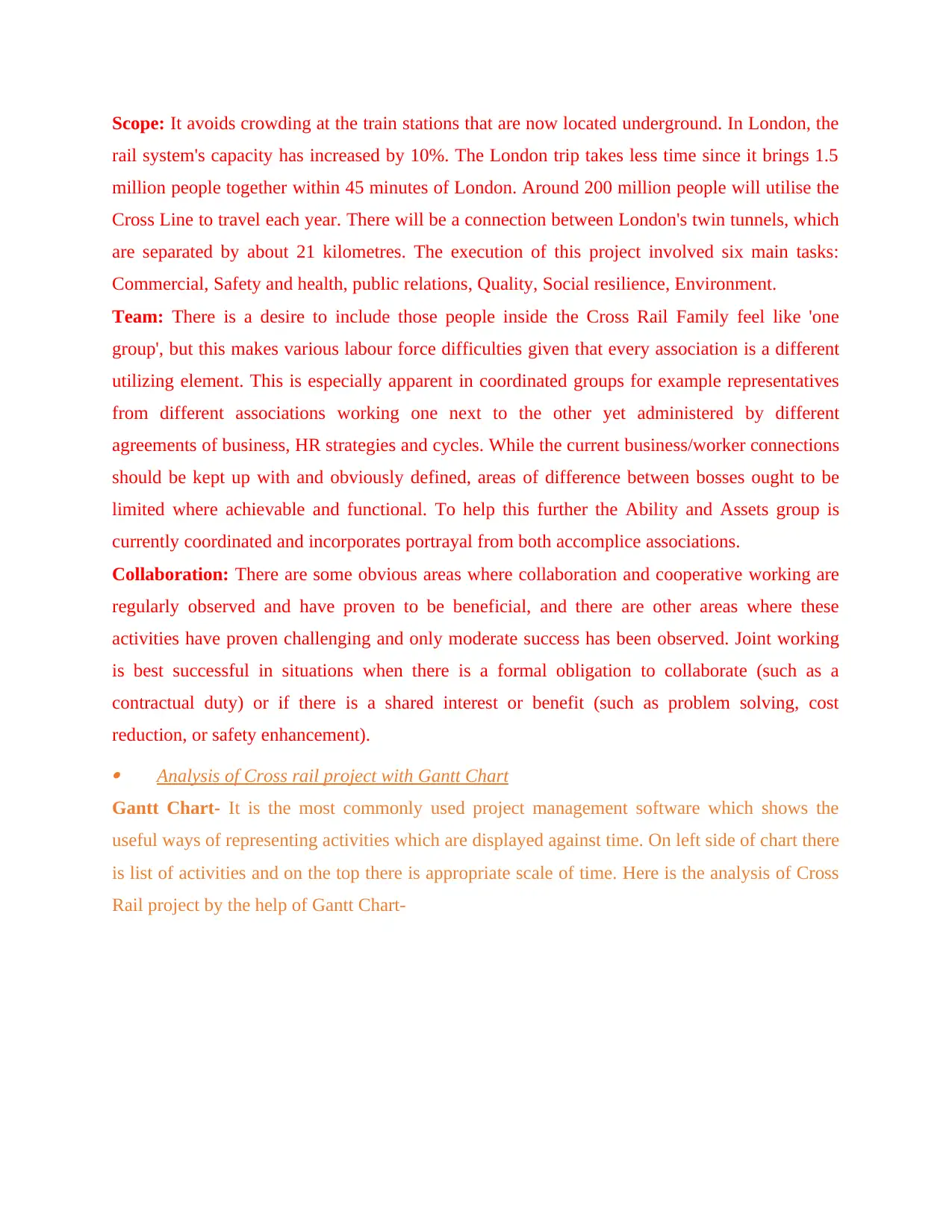
Scope: It avoids crowding at the train stations that are now located underground. In London, the
rail system's capacity has increased by 10%. The London trip takes less time since it brings 1.5
million people together within 45 minutes of London. Around 200 million people will utilise the
Cross Line to travel each year. There will be a connection between London's twin tunnels, which
are separated by about 21 kilometres. The execution of this project involved six main tasks:
Commercial, Safety and health, public relations, Quality, Social resilience, Environment.
Team: There is a desire to include those people inside the Cross Rail Family feel like 'one
group', but this makes various labour force difficulties given that every association is a different
utilizing element. This is especially apparent in coordinated groups for example representatives
from different associations working one next to the other yet administered by different
agreements of business, HR strategies and cycles. While the current business/worker connections
should be kept up with and obviously defined, areas of difference between bosses ought to be
limited where achievable and functional. To help this further the Ability and Assets group is
currently coordinated and incorporates portrayal from both accomplice associations.
Collaboration: There are some obvious areas where collaboration and cooperative working are
regularly observed and have proven to be beneficial, and there are other areas where these
activities have proven challenging and only moderate success has been observed. Joint working
is best successful in situations when there is a formal obligation to collaborate (such as a
contractual duty) or if there is a shared interest or benefit (such as problem solving, cost
reduction, or safety enhancement).
Analysis of Cross rail project with Gantt Chart
Gantt Chart- It is the most commonly used project management software which shows the
useful ways of representing activities which are displayed against time. On left side of chart there
is list of activities and on the top there is appropriate scale of time. Here is the analysis of Cross
Rail project by the help of Gantt Chart-
rail system's capacity has increased by 10%. The London trip takes less time since it brings 1.5
million people together within 45 minutes of London. Around 200 million people will utilise the
Cross Line to travel each year. There will be a connection between London's twin tunnels, which
are separated by about 21 kilometres. The execution of this project involved six main tasks:
Commercial, Safety and health, public relations, Quality, Social resilience, Environment.
Team: There is a desire to include those people inside the Cross Rail Family feel like 'one
group', but this makes various labour force difficulties given that every association is a different
utilizing element. This is especially apparent in coordinated groups for example representatives
from different associations working one next to the other yet administered by different
agreements of business, HR strategies and cycles. While the current business/worker connections
should be kept up with and obviously defined, areas of difference between bosses ought to be
limited where achievable and functional. To help this further the Ability and Assets group is
currently coordinated and incorporates portrayal from both accomplice associations.
Collaboration: There are some obvious areas where collaboration and cooperative working are
regularly observed and have proven to be beneficial, and there are other areas where these
activities have proven challenging and only moderate success has been observed. Joint working
is best successful in situations when there is a formal obligation to collaborate (such as a
contractual duty) or if there is a shared interest or benefit (such as problem solving, cost
reduction, or safety enhancement).
Analysis of Cross rail project with Gantt Chart
Gantt Chart- It is the most commonly used project management software which shows the
useful ways of representing activities which are displayed against time. On left side of chart there
is list of activities and on the top there is appropriate scale of time. Here is the analysis of Cross
Rail project by the help of Gantt Chart-
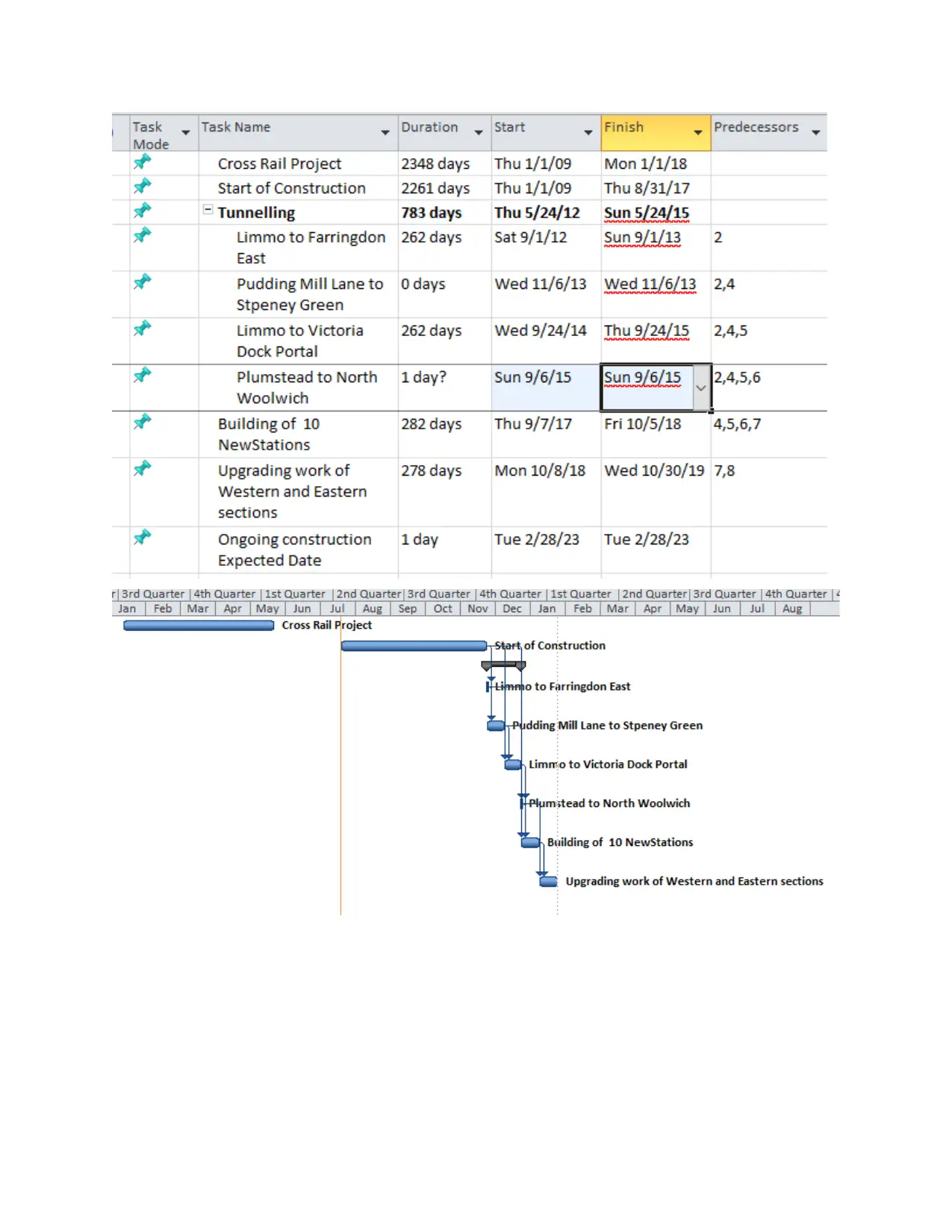
Paraphrase This Document
Need a fresh take? Get an instant paraphrase of this document with our AI Paraphraser
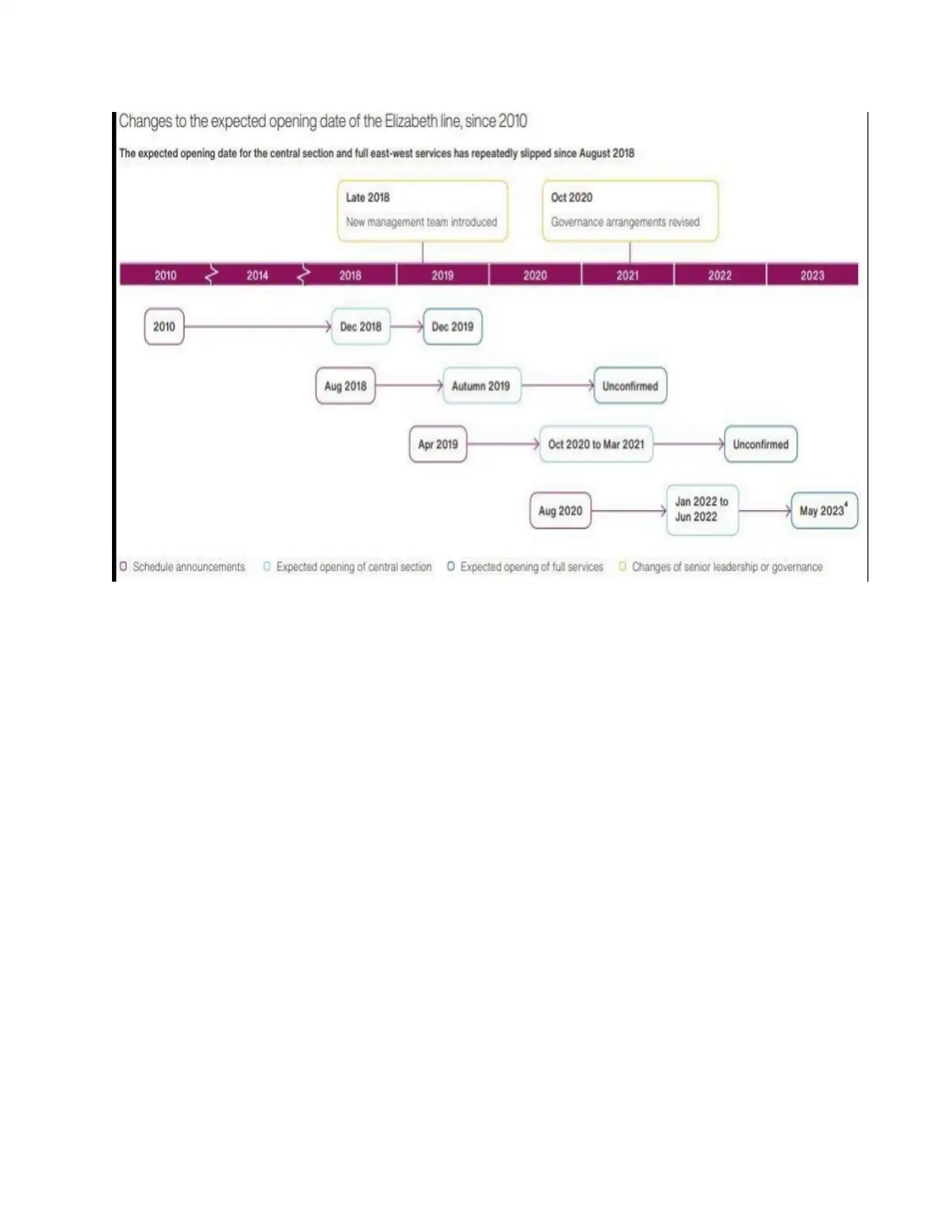
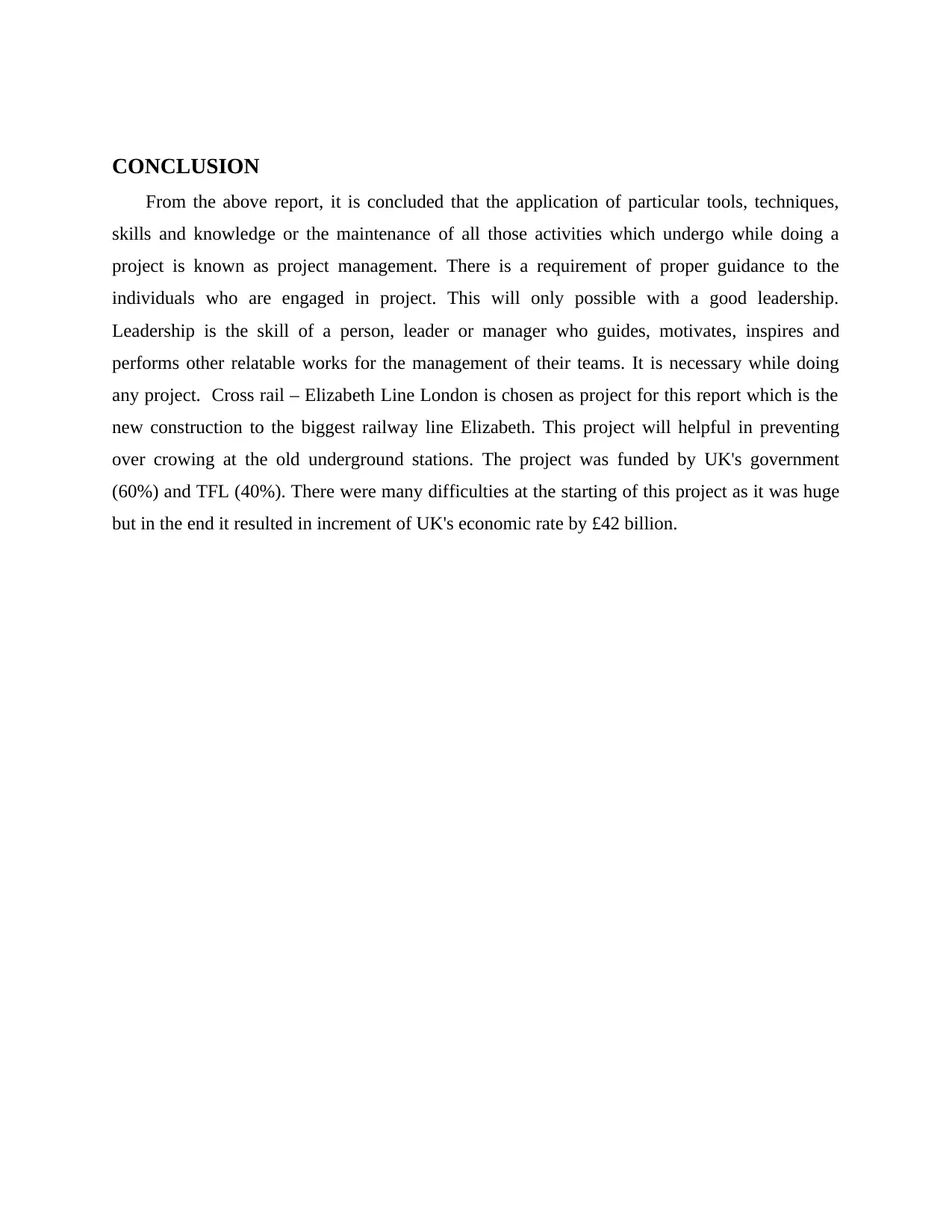
CONCLUSION
From the above report, it is concluded that the application of particular tools, techniques,
skills and knowledge or the maintenance of all those activities which undergo while doing a
project is known as project management. There is a requirement of proper guidance to the
individuals who are engaged in project. This will only possible with a good leadership.
Leadership is the skill of a person, leader or manager who guides, motivates, inspires and
performs other relatable works for the management of their teams. It is necessary while doing
any project. Cross rail – Elizabeth Line London is chosen as project for this report which is the
new construction to the biggest railway line Elizabeth. This project will helpful in preventing
over crowing at the old underground stations. The project was funded by UK's government
(60%) and TFL (40%). There were many difficulties at the starting of this project as it was huge
but in the end it resulted in increment of UK's economic rate by £42 billion.
From the above report, it is concluded that the application of particular tools, techniques,
skills and knowledge or the maintenance of all those activities which undergo while doing a
project is known as project management. There is a requirement of proper guidance to the
individuals who are engaged in project. This will only possible with a good leadership.
Leadership is the skill of a person, leader or manager who guides, motivates, inspires and
performs other relatable works for the management of their teams. It is necessary while doing
any project. Cross rail – Elizabeth Line London is chosen as project for this report which is the
new construction to the biggest railway line Elizabeth. This project will helpful in preventing
over crowing at the old underground stations. The project was funded by UK's government
(60%) and TFL (40%). There were many difficulties at the starting of this project as it was huge
but in the end it resulted in increment of UK's economic rate by £42 billion.
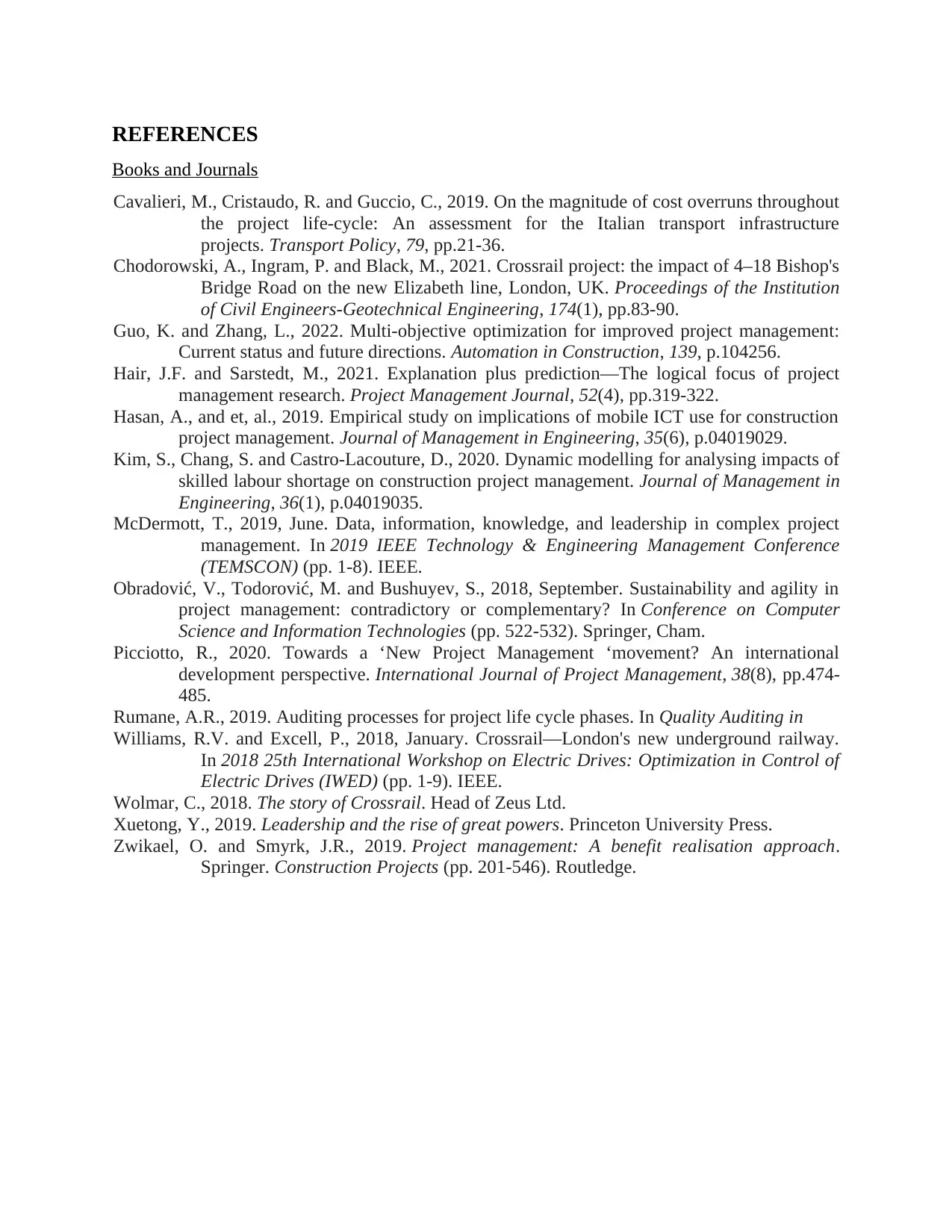
REFERENCES
Books and Journals
Cavalieri, M., Cristaudo, R. and Guccio, C., 2019. On the magnitude of cost overruns throughout
the project life-cycle: An assessment for the Italian transport infrastructure
projects. Transport Policy, 79, pp.21-36.
Chodorowski, A., Ingram, P. and Black, M., 2021. Crossrail project: the impact of 4–18 Bishop's
Bridge Road on the new Elizabeth line, London, UK. Proceedings of the Institution
of Civil Engineers-Geotechnical Engineering, 174(1), pp.83-90.
Guo, K. and Zhang, L., 2022. Multi-objective optimization for improved project management:
Current status and future directions. Automation in Construction, 139, p.104256.
Hair, J.F. and Sarstedt, M., 2021. Explanation plus prediction—The logical focus of project
management research. Project Management Journal, 52(4), pp.319-322.
Hasan, A., and et, al., 2019. Empirical study on implications of mobile ICT use for construction
project management. Journal of Management in Engineering, 35(6), p.04019029.
Kim, S., Chang, S. and Castro-Lacouture, D., 2020. Dynamic modelling for analysing impacts of
skilled labour shortage on construction project management. Journal of Management in
Engineering, 36(1), p.04019035.
McDermott, T., 2019, June. Data, information, knowledge, and leadership in complex project
management. In 2019 IEEE Technology & Engineering Management Conference
(TEMSCON) (pp. 1-8). IEEE.
Obradović, V., Todorović, M. and Bushuyev, S., 2018, September. Sustainability and agility in
project management: contradictory or complementary? In Conference on Computer
Science and Information Technologies (pp. 522-532). Springer, Cham.
Picciotto, R., 2020. Towards a ‘New Project Management ‘movement? An international
development perspective. International Journal of Project Management, 38(8), pp.474-
485.
Rumane, A.R., 2019. Auditing processes for project life cycle phases. In Quality Auditing in
Williams, R.V. and Excell, P., 2018, January. Crossrail—London's new underground railway.
In 2018 25th International Workshop on Electric Drives: Optimization in Control of
Electric Drives (IWED) (pp. 1-9). IEEE.
Wolmar, C., 2018. The story of Crossrail. Head of Zeus Ltd.
Xuetong, Y., 2019. Leadership and the rise of great powers. Princeton University Press.
Zwikael, O. and Smyrk, J.R., 2019. Project management: A benefit realisation approach.
Springer. Construction Projects (pp. 201-546). Routledge.
Books and Journals
Cavalieri, M., Cristaudo, R. and Guccio, C., 2019. On the magnitude of cost overruns throughout
the project life-cycle: An assessment for the Italian transport infrastructure
projects. Transport Policy, 79, pp.21-36.
Chodorowski, A., Ingram, P. and Black, M., 2021. Crossrail project: the impact of 4–18 Bishop's
Bridge Road on the new Elizabeth line, London, UK. Proceedings of the Institution
of Civil Engineers-Geotechnical Engineering, 174(1), pp.83-90.
Guo, K. and Zhang, L., 2022. Multi-objective optimization for improved project management:
Current status and future directions. Automation in Construction, 139, p.104256.
Hair, J.F. and Sarstedt, M., 2021. Explanation plus prediction—The logical focus of project
management research. Project Management Journal, 52(4), pp.319-322.
Hasan, A., and et, al., 2019. Empirical study on implications of mobile ICT use for construction
project management. Journal of Management in Engineering, 35(6), p.04019029.
Kim, S., Chang, S. and Castro-Lacouture, D., 2020. Dynamic modelling for analysing impacts of
skilled labour shortage on construction project management. Journal of Management in
Engineering, 36(1), p.04019035.
McDermott, T., 2019, June. Data, information, knowledge, and leadership in complex project
management. In 2019 IEEE Technology & Engineering Management Conference
(TEMSCON) (pp. 1-8). IEEE.
Obradović, V., Todorović, M. and Bushuyev, S., 2018, September. Sustainability and agility in
project management: contradictory or complementary? In Conference on Computer
Science and Information Technologies (pp. 522-532). Springer, Cham.
Picciotto, R., 2020. Towards a ‘New Project Management ‘movement? An international
development perspective. International Journal of Project Management, 38(8), pp.474-
485.
Rumane, A.R., 2019. Auditing processes for project life cycle phases. In Quality Auditing in
Williams, R.V. and Excell, P., 2018, January. Crossrail—London's new underground railway.
In 2018 25th International Workshop on Electric Drives: Optimization in Control of
Electric Drives (IWED) (pp. 1-9). IEEE.
Wolmar, C., 2018. The story of Crossrail. Head of Zeus Ltd.
Xuetong, Y., 2019. Leadership and the rise of great powers. Princeton University Press.
Zwikael, O. and Smyrk, J.R., 2019. Project management: A benefit realisation approach.
Springer. Construction Projects (pp. 201-546). Routledge.
1 out of 22
Related Documents
Your All-in-One AI-Powered Toolkit for Academic Success.
+13062052269
info@desklib.com
Available 24*7 on WhatsApp / Email
![[object Object]](/_next/static/media/star-bottom.7253800d.svg)
Unlock your academic potential
© 2024 | Zucol Services PVT LTD | All rights reserved.





